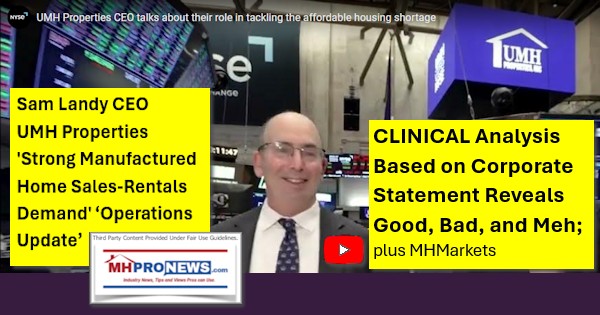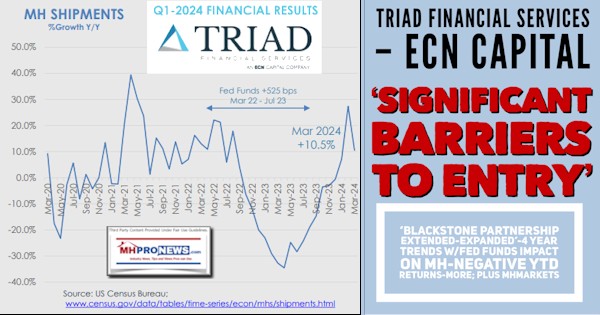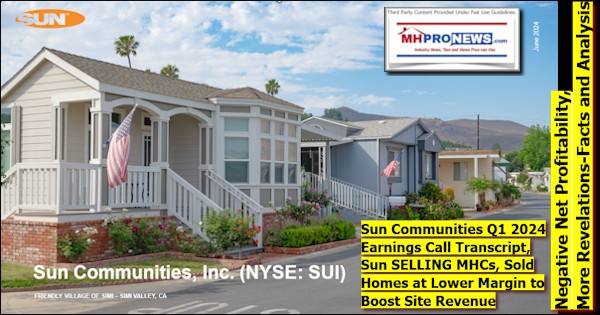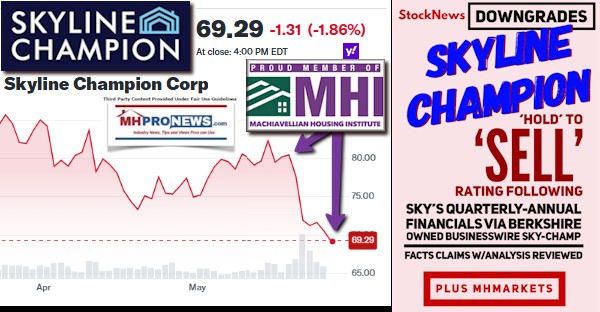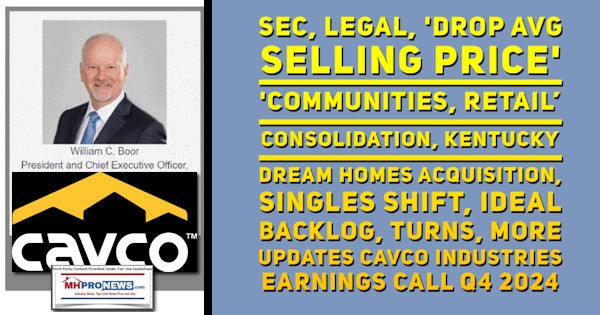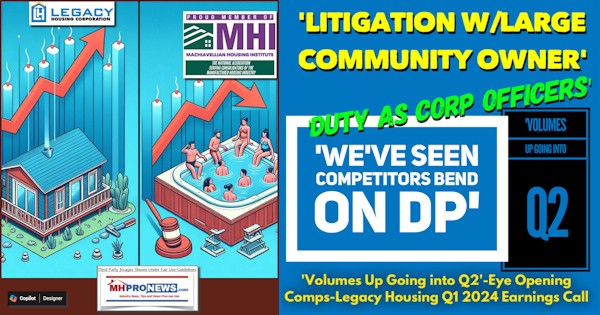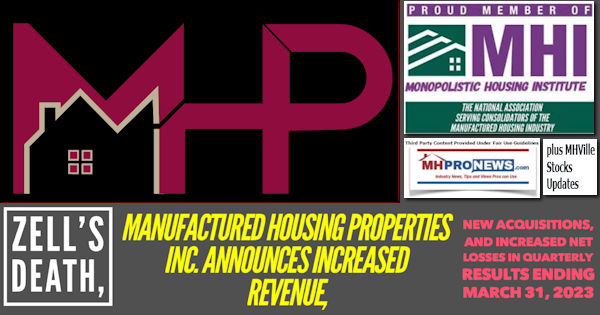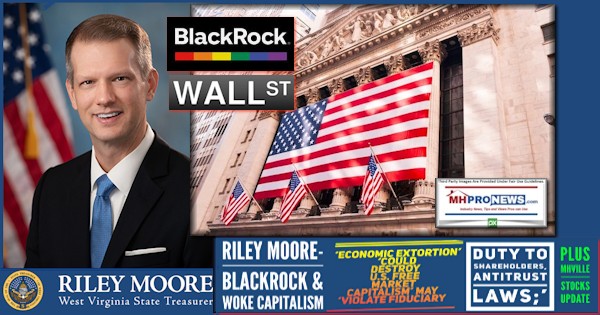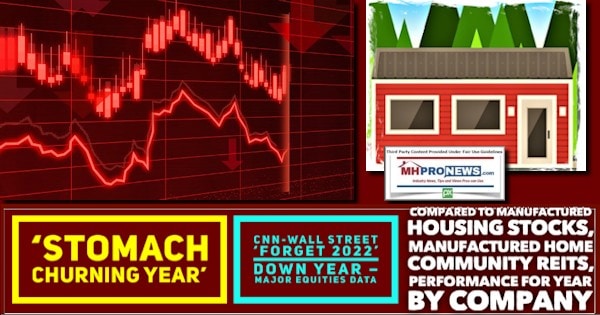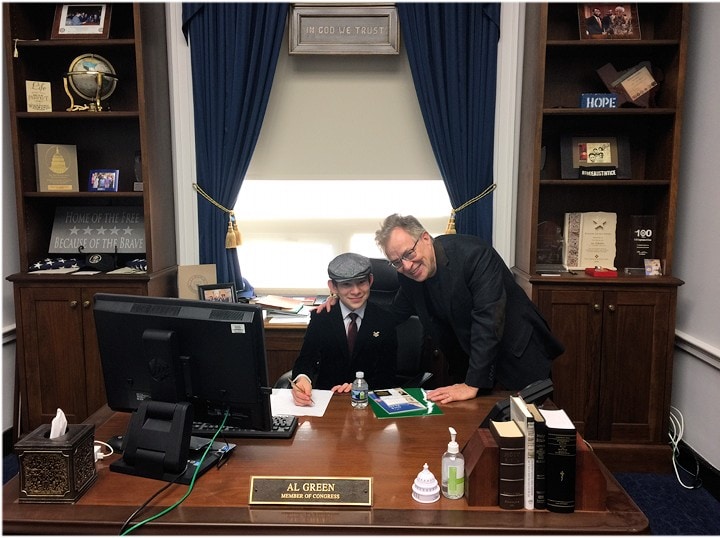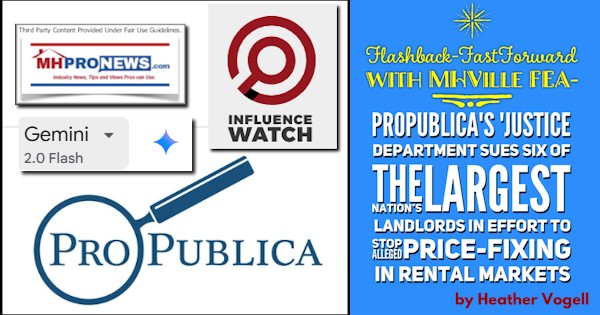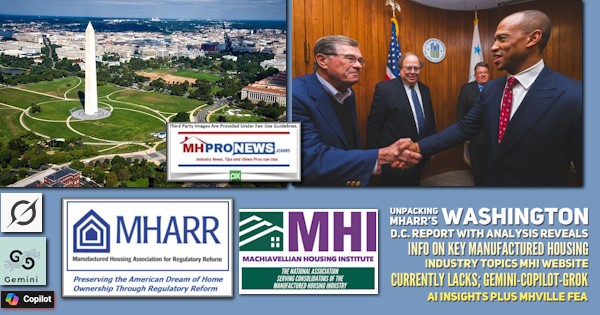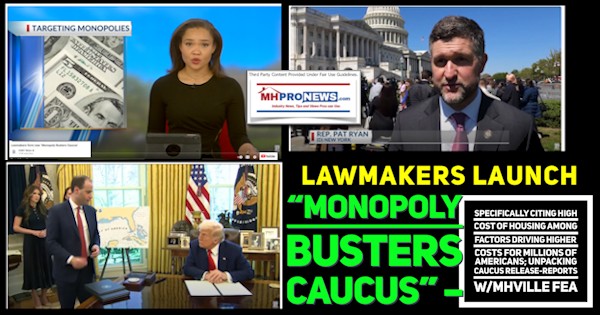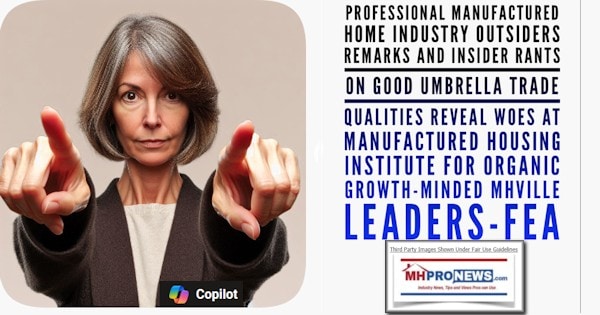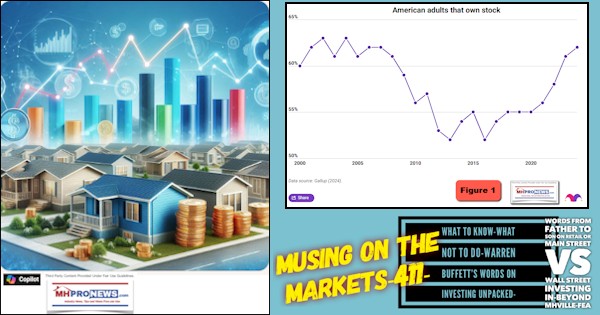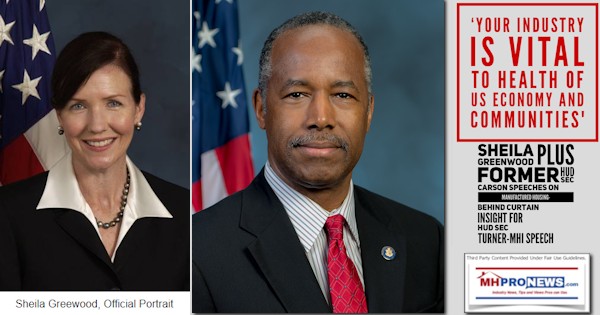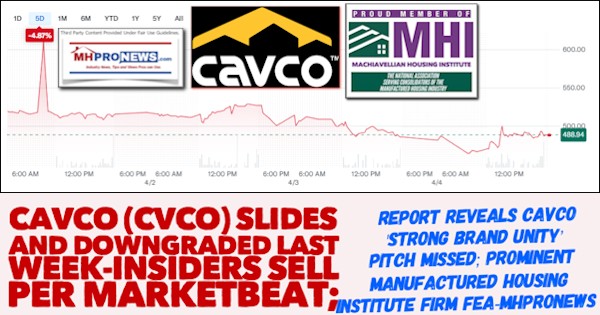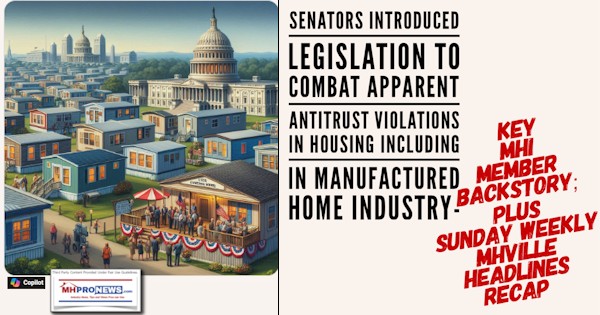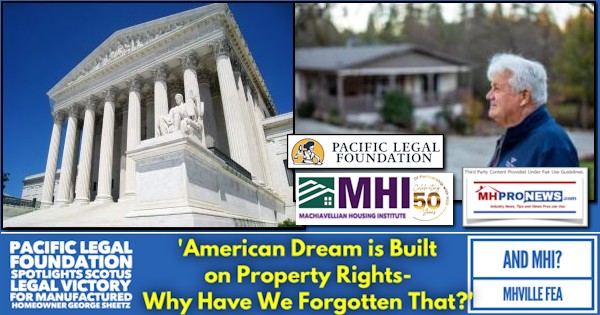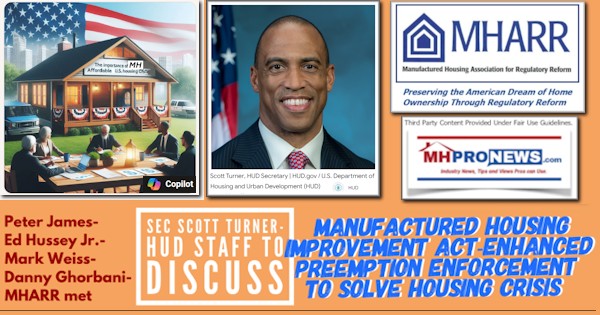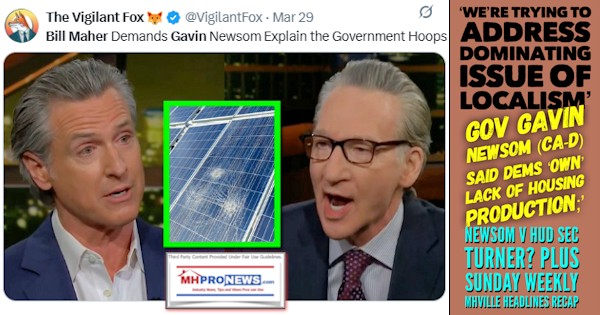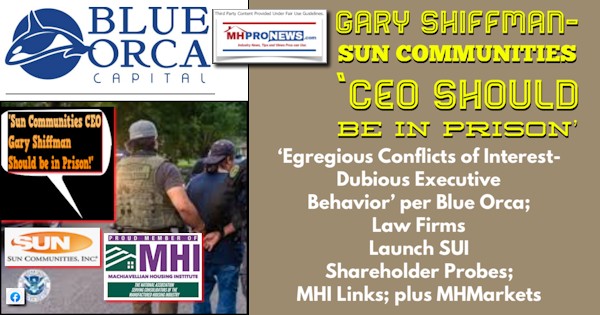
According to Blue Orca: “an attorney provided a sworn statement that a Department of Homeland Security agent involved in the investigation said that the CEO “should be in prison.” This scandal, in our view, raises significant questions as to management credibility and trustworthiness as a steward of investor capital.” Their report said that “undisclosed to investors” “Our diligence reveals that SUI’s CEO received an undisclosed $4 million loan from the family of a purportedly independent Director who has sat on the Audit Committee and chaired the Compensation Committee for close to a decade.” “Incredibly, SUI’s CEO was also embroiled in a scandal involving the falsification of his mother’s medical records to facilitate the fraudulent sale of $63 million of life insurance policies he took out on his mother’s life. Although he was not charged or formally accused of wrongdoing by law enforcement, in a sworn deposition, the physician who faked the medical records accused the CEO of personally directing the insurance fraud scheme. Further, an attorney provided a sworn statement that a Department of Homeland Security agent involved in the investigation said that the CEO “should be in prison,” per Blue Orca’s pitch that for reasons that they are short on higher profile Manufactured Housing Institute (MHI) member Sun Communities (SUI).
Among the claims made by Blue Orca in their report that follows in Part IV is as follows.
History of Alleged Accounting Shenanigans and Reporting Failures Casts Shadow Over Current Financials. Sun Communities is no stranger to allegations of financial impropriety under its still-current CEO. The SEC settled an enforcement action against the Company, and then filed a district court lawsuit against CEO Shiffman, SUI’s then CFO, and its former Controller for hiding losses in a subsidiary and maintaining a literal “cookie jar” reserve to smooth earnings. The SEC eventually dismissed Shiffman and the former Controller from the lawsuit, but notably it settled the lawsuit against SUI’s then-CFO, requiring him to serve a two-year suspension from practicing before the SEC as an accountant (though, surprisingly, he remained with the Company in another capacity).
At the top of the Blue Orca document is this disclosure.
THIS RESEARCH REPORT EXPRESSES SOLELY OUR OPINIONS. We are short sellers.
We are biased. So are long investors. So is SUI. So are the banks that raised money for the Company. If you are invested (either long or short) in SUI so are you. Just because we are biased does not mean that we are wrong. …”
Each of the law firms that have issued a brief press release on this topic cited below (Parts I-II-III) named the Blue Orca research as part of the basis for their concerns.
While they do not cite MHProNews, several of the items in their report are on topics and purported evidence of corrupt behavior that MHProNews previously reported about Sun’s Gary Shiffman and the firm he leads. Our site metrics reveals a surge of interest in those articles, which may be from a combination of Blue Orca, potential litigators, and others concerned about the issues that law firms and Blue Orca has raised.
As is our custom, MHProNews is not endorsing any of the firms referenced in this report with analysis. The claims are theirs. That said, what makes this of potential interest are several evidence-supported and seemingly plausible concerns raised by Blue Orca, which when combined with other issues previously reported here on MHProNews and/or on our MHLivingNews sister site paints a dim picture about the leadership of Sun that would tolerate such claimed behavior.
In our view, while Blue Orca raised some new issues from our perspective, there are other issues that they, possible litigators on behalf of investors, and public officials have apparently not yet raised.
Additionally, there is the point that several of the antitrust actions involving other MHI members including Sun in our expert reading of their respective evidence-based allegations raised issue not only about Sun and those named firms, but also about a frequent common link. Namely, MHI and several MHI-linked state associations.
In no particular order of importance are three of potentially even more such announced probes by law firms on behalf of investors in Sun. One would think that those law firms have considered what Blue Orca and other sources, including MHProNews, have published about Sun and find if in their view there was sufficient substance to the concerns warranting their time, interest, and effort.
Following those three legal press releases are extensive portions of Blue Orca’s detailed narrative and stated evidence in Part IV, with the PDF of their allegations found here.
The markets report will be in Part VI and our insights and potentially related resources in brief are found in Part V. Note that the illustration below using Yahoo Finance data and stock trends indicates that the sharp fall shown was about the time and since the Blue Orca report was released.

Part I – Sun Communities Alert According to Block & Leviton
Sun Communities, Inc. Investors Who Have Lost Money Should Contact Block & Leviton to Find Out How They Might Recover Money Through The Firm’s Investigation
News provided by
ACCESSWIRE
Sep 26, 2024, 9:40 AM ET
BOSTON, MA / ACCESSWIRE / September 26, 2024 / Block & Leviton is investigating Sun Communities, Inc. (NYSE:SUI) for potential securities law violations. Investors who have lost money in their Sun Communities, Inc. investment should contact the firm to learn more about how they might recover those losses. For more details, visit https://blockleviton.com/cases/sui.
What is this all about?
Shares of Sun Communities are down following the release of a Blue Orca Capital report on September 25, 2024. The report alleges that Sun Communities, Inc.’s CEO had an “undisclosed $4 million loan from the family of a purported independent Director who has sat on the Audit Committee and chaired the Compensation Committee for over a decade,” and “this is not the only undisclosed personal loan we [Blue Orca] uncovered from a SUI Board member to the CEO.” We are investigating the company.
Who is eligible?
Anyone who purchased Sun Communities, Inc. common stock and has seen their shares fall may be eligible, whether or not they have sold their investment. Investors should contact Block & Leviton to learn more.
What is Block & Leviton doing?
Block & Leviton is investigating whether the Company committed securities law violations and may file an action to attempt to recover losses on behalf of investors who have lost money.
What should you do next?
If you’ve lost money on your investment, you should contact Block & Leviton to learn more via our case website, by email at shareholders@blockleviton.com, or by phone at (888) 256-2510.
Whistleblower?
If you have non-public information about Sun Communities, Inc., you should consider assisting in our investigation or working with our attorneys to file a report with the Securities Exchange Commission under their whistleblower program. Whistleblowers who provide original information to the SEC may receive rewards of up to 30% of any successful recovery. For more information, contact Block & Leviton at shareholders@blockleviton.com or by phone at (888) 256-2510.
Why should you contact Block & Leviton?
Block & Leviton is widely regarded as one of the leading securities class action firms in the country. Our attorneys have recovered billions of dollars for defrauded investors and are dedicated to obtaining significant recoveries on behalf of our clients through active litigation in the federal courts across the country. Many of the nation’s top institutional investors hire us to represent their interests. You can learn more about us at our website www.blockleviton.com, call (888) 256-2510 or email shareholders@blockleviton.com with any questions.
This notice may constitute attorney advertising.
CONTACT:
BLOCK & LEVITON LLP
260 Franklin St., Suite 1860
Boston, MA 02110
Phone: (888) 256-2510
Email: shareholders@blockleviton.com
SOURCE: Block & Leviton LLP ##
Part II – Per Bragar Eagel & Squire, P.C.
SUN COMMUNITIES ALERT: Bragar Eagel & Squire, P.C. is Investigating Sun Communities on Behalf of Sun Communities Stockholders and Encourages Investors to Contact the Firm
Provided by GlobeNewswire
Sep 26, 2024 9:00pm
NEW YORK, Sept. 26, 2024 (GLOBE NEWSWIRE) — Bragar Eagel & Squire, P.C., a nationally recognized stockholder rights law firm, is investigating potential claims against Sun Communities (“Sun Communities” or the “Company”) (NYSE: SUI) on behalf of Sun Communities stockholders. Our investigation concerns whether Sun Communities has violated the federal securities laws and/or engaged in other unlawful business practices.
Click here to participate in the action.
On September 25, 2024, Blue Orca Capital published a report concerning Sun Communities. In this report, Blue Orca Capital stated that “Our diligence reveals that SUI’s CEO received an undisclosed $4 million loan from the family of a purportedly independent Director who has sat on the Audit Committee and chaired the Compensation Committee for close to a decade. Put simply, undisclosed to investors, the family of a Board member overseeing the CEO’s compensation and Company controls has been lending the CEO money to finance the purchase of luxury real estate. Stunningly, this is not the only undisclosed personal loan we uncovered from a SUI Board member to the CEO.”
Following the release of this report, a decrease in the Company’s share price was observed during the early morning trading on the same day, September 25, 2024.
If you purchased or otherwise acquired Sun Communities shares and suffered a loss, are a long-term stockholder, have information, would like to learn more about these claims, or have any questions concerning this announcement or your rights or interests with respect to these matters, please contact Brandon Walker or Marion Passmore by email at investigations@bespc.com, by telephone at (212) 355-4648, or by filling out this contact form. There is no cost or obligation to you.
About Bragar Eagel & Squire, P.C.:
Bragar Eagel & Squire, P.C. is a nationally recognized law firm with offices in New York and California. The firm represents individual and institutional investors in commercial, securities, derivative, and other complex litigation in state and federal courts across the country. For more information about the firm, please visit www.bespc.com. Attorney advertising. Prior results do not guarantee similar outcomes.
Contact Information:
Bragar Eagel & Squire, P.C.
Brandon Walker, Esq.
Marion Passmore, Esq.
(212) 355-4648
investigations@bespc.com
www.bespc.com##
Part III – According to Pomerantz LLP re: SUI
SHAREHOLDER ALERT: Pomerantz Law Firm Investigates Claims On Behalf of Investors of Sun Communities, Inc. – SUI
News provided by
ACCESSWIRE
Sep 26, 2024, 4:45 PM ET
NEW YORK, NY / ACCESSWIRE / September 26, 2024 / Pomerantz LLP is investigating claims on behalf of investors of Sun Communities, Inc. (“Sun” or the “Company”) (NYSE:SUI). Such investors are advised to contact Danielle Peyton at newaction@pomlaw.com or 646-581-9980, ext. 7980.
The investigation concerns whether Sun and certain of its officers and/or directors have engaged in securities fraud or other unlawful business practices.
[Click here for information about joining the class action]
On July 30, 2024, Paragon 28 disclosed that its previously reported financial results On September 25, 2024, Blue Orca Capital (“Blue Orca”) published a report alleging that Sun’s Chief Executive Officer (“CEO”) had an “undisclosed $4 million loan from the family of a purported independent Director who has sat on the Audit Committee and chaired the Compensation Committee for over a decade,” and that Blue Orca had also “uncovered” additional personal loans from members of Sun’s board of directors to the CEO.
Following publication of the Blue Orca report, Sun’s stock price fell $1.62 per share, or 1.16%, to close at $137.48 per share on September 25, 2024.
Pomerantz LLP, with offices in New York, Chicago, Los Angeles, London, Paris, and Tel Aviv, is acknowledged as one of the premier firms in the areas of corporate, securities, and antitrust class litigation. Founded by the late Abraham L. Pomerantz, known as the dean of the class action bar, Pomerantz pioneered the field of securities class actions. Today, more than 85 years later, Pomerantz continues in the tradition he established, fighting for the rights of the victims of securities fraud, breaches of fiduciary duty, and corporate misconduct. The Firm has recovered billions of dollars in damages awards on behalf of class members. See www.pomlaw.com.
Attorney advertising. Prior results do not guarantee similar outcomes.
SOURCE: Pomerantz LLP ##
Part IV – According to Blue Orca

(Note highlighting in what follows is added by MHProNews. Blue Orca and MHProNews logos added to several illustrations so that those finding those items online know the source).

COMPANY: Sun Communities, Inc. │ NYSE: SUI
INDUSTRY: Manufactured Home / RV REIT
We are short Sun Communities, Inc. (“SUI” or the “Company”), an egregious mess of conflicts
of interest and dubious executive behavior which we believe manipulates critical financial
disclosures to inflate adjusted funds from operation (“AFFO”) and organic growth.
Our diligence reveals that SUI’s CEO received an undisclosed $4 million loan from the family of
a purportedly independent Director who has sat on the Audit Committee and chaired the
Compensation Committee for close to a decade. Put simply, undisclosed to investors, the family
of a Board member overseeing the CEO’s compensation and Company controls has been lending
the CEO money to finance the purchase of luxury real estate. Stunningly, this is not the only
undisclosed personal loan we uncovered from a SUI Board member to the CEO.
Incredibly, SUI’s CEO was also embroiled in a scandal involving the falsification of his mother’s medical records to facilitate
the fraudulent sale of $63 million of life insurance policies he took out on his mother’s life. Although he was not charged or
formally accused of wrongdoing by law enforcement, in a sworn deposition, the physician who faked the medical records accused
the CEO of personally directing the insurance fraud scheme. Further, an attorney provided a sworn statement that a Department
of Homeland Security agent involved in the investigation said that the CEO “should be in prison.” This scandal, in our view,
raises significant questions as to management credibility and trustworthiness as a steward of investor capital.
Management credibility is central to SUI’s valuation because SUI is such a curious outlier compared to peers: by our estimate,
SUI’s peers (including its closest comp in the same industry) report 4-8x more recurring capex than SUI. The reason? We
believe that SUI arbitrarily excludes 26% of its mobile home / RV sites from recurring capex disclosures. It also excludes regular,
reoccurring capital spending required to replace departing tenants, an accounting treatment which has reportedly received push
back even from sell-side analysts. This inflates AFFO, a central component to how the market values REITs and the most
common metric on which analysts value SUI. Assuming constant AFFO multiples, our FY23 recurring capex adjustments
imply that SUI’s share price is inflated by 48%. We also find evidence to suggest, in our opinion, that the Company inflates
organic growth.
SUI is no stranger to allegations of financial impropriety. In the mid-2000s, the SEC settled an enforcement action against SUI,
and then sued several executives (including its still current CEO) for hiding losses in a subsidiary and maintaining a literal
“cookie jar” reserve to smooth earnings. The Company and the CFO settled, with the CFO agreeing to a two-year suspension
from practicing before the SEC as an accountant. The other defendants were dismissed. But we see parallels between this alleged
conduct and SUI’s conduct today, as SUI was forced to restate FY 2023 financials after reporting a material weakness around
goodwill impairment evaluations.
SUI is already heavily levered and has little room to maneuver at 6.0x Net Debt / Recurring EBITDA. Ultimately, we view SUI
as egregious governance failure tainted by scandal, whose business is growing far slower and generates far less AFFO than
investors are led to believe.
1) CEO Received Undisclosed $4 Million Mortgage from Family of Compensation Committee Chair. Undisclosed to investors, a purportedly independent Board member is a “closely-knit” stepcousin of SUI’s CEO whose family recently provided him with a $4 million loan to purchase one of the “most expensive homes for sale in Michigan.” What’s more, local property records indicate that the Board member’s family previously owned the home, and that they sold it to the CEO at a price approximately $2 million below the last public listing price. This purportedly “independent” Board member has been Chair of the Compensation Committee and a member of the Audit Committee since 2015, and is cited as an independent
Director despite his undisclosed personal financial ties to the CEO. We believe that such a large undisclosed loan from the family of a supposedly “independent” Board member who has played a role in two critical committees for close to a decade raises serious question about the integrity of the Company’s governance, controls, and financial disclosures. Incredibly, this is not the only time that the CEO has received an undisclosed loan from someone connected to a SUI Board member. In a deposition under oath, SUI’s CEO admitted to borrowing $700,000, among other loans, from a Board member who is a partner at the law firm that serves as SUI’s General Counsel. In our view, this tangled web of conflicts and undisclosed borrowings require an immediate investigation by an independent law firm and should likely be disqualifying to both the Board members and CEO.
2) CEO Embroiled in Life Insurance Fraud Scheme. Associates of SUI Founder-CEO Gary Shiffman were accused of multi-million dollar fraud surrounding the sale of $63 million of life insurance policies taken out by Shiffman on his mother’s life. Federal prosecutors alleged that a physician falsified Shiffman’s mother’s medical records and fabricated dementia and diabetes diagnoses, making the policies appear far more valuable and therefore easier to sell. Shiffman was neither named in the suit nor charged with wrongdoing, and the case was dismissed after an amendment to the charge shortened the statute of limitations.
However, in subsequent litigation brought against Shiffman by friends and family of the indicted parties, the physician, under oath, accused Shiffman of personally directing the scheme. Furthermore, an attorney provided a sworn statement that a Department of Homeland Security agent involved in the case said that Shiffman “should be in prison.” According to the federal indictment, Shiffman appears to have been under financial strain at the time, owing over $30 million to various creditors and having just $119,848 in cash and cash equivalents.
The allegations involving and against Shiffman have received minimal media coverage. To our knowledge, the Company acknowledged the existence of the investigation into Shiffman only once, in a disclosure buried on the fourth page of a six-page 8-K issued primarily to announce an unrelated $2.11 billion acquisition. Investors appear to be unaware of any of these developments involving the CEO. In our view, his very proximity to this scandal is disqualifying for leadership of a public company, and the allegations lodged against him under oath only serve to undermine the remaining credibility he may have. This scandal heightens our concerns surrounding the accounting and financial anomalies highlighted throughout the rest of this report.
3) AFFO Inflated by Underreported Recurring Capex, Propping Up Excessive Valuations. We believe that SUI trades at an unjustified premium because, in our opinion, the Company underreports recurring capital expenditures, significantly inflating analyst and investor calculations of AFFO and thus its share price. We think that SUI maintains an aggressively broad definition of growth-oriented “non-recurring” capex that defies industry norms and common sense, giving it the lowest share of recurring capex (as a percentage of total capex) among its peer group by a dramatic margin.
SUI stands out as a major and inexplicable outlier among peers. Other REITs (including manufactured home REITs) report 4-8x times more recurring capex, measured as a percentage of total, than SUI. We believe that this is due to SUI’s inclusion of capex categories within “non-recurring” capex which rightly belong under the “recurring” classification. For example, a Company representative stated that SUI defines all capex associated with recently acquired sites as part of non-recurring capex, regardless of whether it is recurring in nature. Our calculations indicate that SUI excludes all capex associated with 26% of MH/RV sites and 15% of marina slips from recurring capex, even if elements of that capex are in fact recurring. Furthermore, the Company representative told us that sell side analysts have questioned SUI’s categorization of capital spending for lot modification as non-recurring, since this capex is required to replace departing tenants with new tenants.
When we adjust for capex associated with recently acquired properties and lot modifications, we estimate that sellside calculations of the Company’s AFFO were inflated by 60% in FY22 and 48% in FY23. Assuming constant AFFO multiples, SUI trades 48% above appropriate levels based on our FY23 recurring capex adjustments.
We think that management’s persistent and aggressive minimization of recurring capex has given analysts investors a misleading view of the Company’s financial results, resulting in chronic and significant overvaluation of the stock.
4) Organic Growth Manipulated through Inclusion of Converted and Expanded Properties. We believe that SUI inflates organic growth metrics by including converted RV sites in its same property sales and NOI calculations. SUI is currently transitioning several thousand of its RV sites from “transient” sites designed for temporary stays into “annual” sites designed for stays of a year or more. Per management, this has increased revenue at converted sites by as much as 50-60% in recent years. But management does not exclude these converted sites from its same property calculations, which in our opinion, gives investors a skewed and inaccurate view of organic growth.
The Company also includes manufactured home site expansions within same property growth calculations, which, combined with the effect of RV site transitions, could have inflated MH/RV same property growth by 200 basis points in FY22 and 169 basis points in FY23, or about a third of all growth in both years. When we remove the estimated impact of the Company’s RV transitions and MH site expansions, we calculate that actual same property sales growth at its manufactured home and RV properties is not keeping pace with reported rental rate increases, suggesting that occupancy is trending down. This is a worrisome sign for organic growth on its face, but it is doubly concerning in that it directly contradicts the Company’s own statements regarding same property occupancy rates at its manufactured home and RV sites.
5) History of Alleged Accounting Shenanigans and Reporting Failures Casts Shadow Over Current Financials. Sun Communities is no stranger to allegations of financial impropriety under its still-current CEO. The SEC settled an enforcement action against the Company, and then filed a district court lawsuit against CEO Shiffman, SUI’s then CFO, and its former Controller for hiding losses in a subsidiary and maintaining a literal “cookie jar” reserve to smooth earnings. The SEC eventually dismissed Shiffman and the former Controller from the lawsuit, but notably it settled the lawsuit against SUI’s then-CFO, requiring him to serve a two-year suspension from practicing before the SEC as an accountant (though, surprisingly, he remained with the Company in another capacity).
We believe that SUI’s history of alleged financial impropriety still has implications today. The Company recently took a $370 million write-down on a subsidiary which it acquired for $1.3 billion, recognizing the loss just over a year after the acquisition. It concurrently reported a material weakness around goodwill impairment evaluations and was forced to amend and restate results from prior quarters as a result. We see other parts of the business which continue to demonstrate financial weakness: the marinas segment, for example, requires ~3.5x recurring capex per slip than management originally forecast upon entering the business in FY20.
Given the prior allegations of hiding losses and smoothing earnings under its still-current CEO, we question whether the Company may be delaying the realization of impairments on segments which are long overdue for a write-down. The Company currently has a Net Debt to Recurring EBITDA ratio of 6.0x, higher than any of its peers. We believe that, should the Company have to recognize any such financial hit, it may harm its ability to support its strained organic growth without stretching its balance sheet to an unsustainable degree.
Ultimately, we view SUI as egregious governance failure tainted by scandal, whose business is growing far slower and generates far less AFFO than investors are led to believe.
I. CEO Received Undisclosed $4 Million Mortgage from Family of Compensation Committee Chair
Undisclosed to investors, a purportedly independent Board member is a “closely-knit” stepcousin of SUI’s CEO whose family recently provided the CEO with a $4 million loan for the purchase of a house that was called one of “the most expensive homes for sale in Michigan.” This Board member has been Chair of the Compensation Committee and a member of the Audit Committee since 2015, and is cited as an independent director despite his relationship with and undisclosed financial ties to the CEO. In our opinion, an undisclosed $4 million mortgage from the family of a purportedly independent Board member to the CEO fundamentally compromises the independence of the Compensation Committee and, critically, the Audit Committee, only raising more questions as to the integrity of the Company’s governance, controls and financial disclosures.
Furthermore, the CEO acknowledged in a deposition that he received loans from another Board member who is also a partner of the law firm which serves as SUI’s General Counsel. To our knowledge, no such loans were disclosed by the Company. Notably, the CEO acknowledged that this Board member advanced loans on his behalf to the individuals who were later indicted in the alleged insurance fraud described later in this report.
We believe that this pattern of undisclosed borrowing from Board members by the CEO requires an immediate independent investigation by independent counsel and, in our view, it should be disqualifying to the Board members and the CEO.
CEO Took out Undisclosed $4 Million Mortgage from Family of Chair of Compensation Committee On February 28, 2019, an entity named “DH Bingham Farms LLC” took out a $3.95 million mortgage from David B. Hermelin Trust and Doreen Hermelin Trust, jointly. DH Bingham Farms LLC was registered under the name of SUI CEO Gary Shiffman two days earlier, and he is the signatory for the entity on the mortgage.

Obituaries indicate that David and Doreen Hermelin, whose names are on the trusts that provided the loan, are the father and mother of independent SUI Director Brian Hermelin, respectively.
Brian Hermelin is currently a member of SUI’s Board of Directors and has served on the Board since January 1, 2014, and has served on the Audit Committee since that year. He also currently serves as Chair of the Compensation Committee, a role he has held since 2015. Furthermore, he is explicitly cited as an independent Director, despite his undisclosed relationship with and financial ties to SUI’s CEO.

We have retrieved a warranty deed that shows that the Hermelin family was the previous owner of the property, and that it transferred control of the property to DH Bingham Farms LLC (in a document submitted to “Shiffman Revocable Trust”) in February 2019.

We note that the latest list price for the house on Zillow was $6.995 million on November 17, 2018, at which point the listing was removed after it was labeled as “pending sale.”
We question why the CEO of a public company was apparently able to purchase the house from the family of a purportedly independent Director for $2 million under the reported list price just months later, in February 2019.

Regardless, because the family sold the property directly to the CEO for $4.95 million on a $3.95 million mortgage, we believe that the CEO paid the Director’s family $1 million directly (most likely a down payment of equity on the $4.95 million purchase price, in our opinion) – a payment between the CEO and the family of a purportedly independent Board member which was, again, not disclosed to investors.
Compounding the conflicts of interest created by this loan, our diligence indicates that, Hermelin is a stepcousin of the CEO, and their families reportedly have a “close-knit bond.”[1]

[1] The obituary of CEO Gary Shiffman’s father, Milton Shiffman, published in the Detroit Free Press, says that he was son to Joseph D. Shiffman and Florence Shiffman Hermelin, and stepson to Irving Hermelin (Source: Detroit Free Press, January 26, 2000. Archived online at newspapers.com). This same obituary states that there was a “close-knit bond” between the Shiffman and Hermelin families, and that Milton was also stepbrother to David Hermelin, former ambassador to Norway. The New York Times and Detroit Jewish News obituaries of David Hermelin published in November 2000 state that he was father to Brian Hermelin, and Florence Hermelin’s obituary also lists Brian among her survivors. If we follow the genealogy correctly, this would make Board member Brian Hermelin a stepcousin of the current CEO.
Archived online at the University of Michigan Library.
To our knowledge, this reportedly close family relationship was never disclosed to investors. In our opinion, it undermines any semblance of independence between the CEO and Brian Hermelin, despite the fact the Company holds Mr. Hermelin out as an independent Director.
Ultimately, the fact that the CEO took out a nearly $3.95 million mortgage from the family of an independent Director who has been Chair of the Compensation Committee and a member of the Audit Committee for close to a decade represents, in our opinion, an egregious violation of corporate governance standards that casts serious doubt on SUI’s internal controls. That the family of the Board member apparently sold the CEO the house for a price dramatically below the last listed price also raises a host of questions as to why this deal was never disclosed to investors.
Loans and Further Conflicts of Interest Between Shiffman and Another Board Member / General Counsel
Incredibly, this is not the only instance in which, undisclosed to investors, the CEO has borrowed from Board members or their families. In a deposition given during the legal proceedings discussed later in this report, SUI’s CEO acknowledged that he has borrowed from Arthur Weiss, another member of SUI’s Board and a partner of the law firm that serves as SUI’s General Counsel.
In the deposition conducted on March 28, 2023, SUI CEO Gary Shiffman acknowledged that he and Weiss have “had a relationship over 35 years where we’ve loaned each other money.” In one instance, Weiss paid the doctor implicated in the life insurance fraud $700,000 on behalf of Shiffman, another significant loan which, to our knowledge, went undisclosed to investors.

Weiss has been a Board member since 1996, just three years after SUI went public, and he remains a Board member to this day. He is also partner at law firm Taft Stettinius & Hollister LLP (formerly Jaffe, Raitt, Heuer & Weiss Professional Corporation), which according to the Company’s 10-K, acts as SUI’s General Counsel.

SUI has never disclosed the existence of such loans between Shiffman and Weiss, to our knowledge.
Remarkably, Shiffman’s history of borrowing from Board members may not end there. The federal indictment discussed later in this report alleged that he owed more than $30 million to multiple creditors. Among them was allegedly “a fellow member of the Board of Directors of the company for which [Shiffman] served as chairman and chief executive officer.” While SUI is not mentioned by name, we see no other entity to which “the company” can refer, given the context.

To our knowledge, no such loans between the CEO and any Board member was disclosed by the Company at the time.[2]
In our opinion, repeated undisclosed borrowing by the CEO from these Board members fundamentally compromises the independence of the Board as a whole, the Compensation Committee and, critically, the Audit Committee. In our view, such undisclosed loans only raise more questions as to the integrity of the Company’s governance, controls and financial disclosures. We believe that these large undisclosed loans to the CEO require an immediate investigation by independent outside counsel and, in our view, it should be disqualifying to both the Board members and the CEO.
II. CEO Embroiled in Life Insurance Fraud Scheme
Associates of SUI Founder-CEO Gary Shiffman were criminally indicted of multi-million-dollar fraud surrounding the sale of life insurance policies taken out by Shiffman on his mother’s life. Prosecutors alleged that Shiffman’s mother’s physician falsified her medical records to make her appear severely ill, including by fabricating diagnoses such as dementia and diabetes. As a result of such fabricated medical records, the $63 million in life insurance policies taken out by Shiffman on his mother appeared far more valuable and were therefore far easier for Shiffman to sell.
It is important to note that Shiffman was neither identified by name in the criminal indictment against his associates, nor charged with wrongdoing, and the criminal case against Shiffman’s associates was ultimately dismissed after an amendment to the charges shortened the statute of limitations. Shiffman was identified in the criminal complaint only as “Owner A,” and was never, to our knowledge, formally accused of any wrongdoing, including insurance fraud, by law enforcement or any government authorities.
Yet in subsequent legal proceedings, including civil litigation brought against Shiffman in Michigan by friends and family members of the alleged participants of the scheme, the physician, in a deposition under oath, accused Shiffman of personally directing the life insurance fraud scheme. Further, in other subsequent legal proceedings, an attorney provided a sworn statement that a Department of Homeland Security agent involved in the criminal investigation of the insurance fraud scheme stated that Shiffman “should be in prison.”
The allegations and sworn evidence in the subsequent legal proceedings involving and against Shiffman have received minimal media coverage and have not been addressed by the Company, to our knowledge, outside of a single obscure disclosure buried deep in an unrelated 8-K that offered no details regarding the case.[2] In our view, however, Shiffman’s very proximity to this scandal, not to mention allegations made under oath that Shiffman allegedly participated in and directed the life insurance fraud scheme, is highly concerning for leadership of a public company. In our opinion, such allegations undermine management’s credibility, which we think may provide a relevant backdrop for investors when evaluating the number of questionable accounting disclosures highlighted in this report.
CEO Involved in Alleged Insurance Fraud Scheme
The indictment against Shiffman’s associates charges that, as of 2008, Shiffman (identified in the criminal indictment as “OWNER A”[3]) held six life insurance policies against the life of his aging mother which, together, would pay a total death benefit of approximately $63 million.
Beginning in 2009, Shiffman began to fall behind on premium payments which, per the indictment, were estimated to be approximately $2 million per year. A few of these policies fell into grace in 2009 after Shiffman failed to make required payments, and one of the policies lapsed after a missed $44,608 payment in December of that year.
According to the indictment, a statement of Shiffman’s financial condition drafted by his financial advisor on December 31, 2009, reported that, despite “owning considerable assets,” Shiffman had just $119,848 in cash and cash equivalents. The statement also detailed that he had negative cash flow in 2009 and owing over $30 million “to various individuals and entities,” including his mother.
Allegedly facing personal financial strain, Shiffman tried to sell these policies beginning in late 2008. But his attempts proved unsuccessful. Life expectancy analyses determined that his mother had approximately another 148 to 165 months (~12-14 years) to live. Another examination performed in January 2010 pinned her expected lifespan at 170 months. Potential buyers balked at purchasing the plans, specifically citing the “long LE’s” (life expectancy) in February 2009.
According to the indictment, Shiffman hired local physician Dr. William Gonte to assist him in selling the insurance policies following these unsuccessful attempts to find a buyer. Shiffman entered into a profit-sharing agreement which, per the indictment, granted Dr. Gonte “up to 30% of the proceeds” contingent on the policies being sold within 24 months for more than the premiums paid on the policies, and not less than $3 million.[4] Separately, Shiffman declared the brokerage firm owned by another associate to be the exclusive broker of record for four of the policies.
The subsequent legal proceedings brought even more alleged details of this agreement to light. According to depositions given by both Shiffman and Dr. Gonte, Shiffman scribbled this profit-sharing agreement by hand. While Shiffman said that he did not clearly recall who was present at the time of the drafting, Dr. Gonte said under oath that
Shiffman intended it to be a “secret agreement” between them, and that Shiffman “didn’t want his attorneys to look at it” (referring to his own attorneys). A photograph of the agreement was included as an exhibit in two of the subsequent legal proceedings.
[2] It is possible that the unnamed Director referenced in this part of the indictment is Weiss, from whom Shiffman admitted to taking loans in the past. However, if it refers to a different Board member, then this would represent evidence of Shiffman borrowing from a third Director without disclosing the loan to investors. Even if it does refer to Weiss, the specific loan discussed in this part of the indictment would have been granted in 2009 or earlier, preceding the $700,000 loan granted from Weiss to Shiffman which Shiffman himself acknowledged in his deposition.
[3] An investigation into Shiffman’s sale of life insurance policies was mentioned in a single brief disclosure buried in an unrelated 8-K in September 2020, but neither the details of the case nor the existence of a federal indictment was disclosed, and it was the Company’s last and only acknowledgement of the case, to our knowledge.
[4] As noted, Shiffman was neither charged with wrongdoing nor specifically identified by name in the indictment of his associates. However, Shiffman was later sued by the wife of the doctor and a friend of the broker in separate civil cases for misappropriation and fraud, respectively, in Oakland County, MI (the court found in Shiffman’s favor in both cases). There were also other relevant separate legal proceedings involving Shiffman’s associates at the federal level surrounding the events of the alleged fraud. We collectively refer to all of this subsequent litigation as the “subsequent legal proceedings.” These subsequent proceedings unveiled more of the details surrounding the alleged insurance fraud scheme. Statements made by both Shiffman and his associates during these subsequent proceedings confirm that Shiffman was the individual identified in the criminal indictment against Shiffman’s associates as “OWNER A” who employed the doctor and broker to sell the $63 million worth of life insurance policies.
[5] In a deposition given during one of the subsequent legal proceedings, the doctor claims that another 20% was promised to him by Shiffman, for a total 50% profit share, but 30% was the maximum that Shiffman was “allowed to pay a broker.” He also claimed that, while the agreement was dated February 1, 2009, it was drafted later that summer, and that Shiffman wanted it “predated.”

According to the federal indictment against Shiffman’s associates, Dr. Gonte and the broker struggled to find a buyer for the insurance policies due to the relatively good health of his mother, and Shiffman continued to fall behind on his premium payments. The indictment states that Shiffman received notices from counterparties of past-due payments as late as March 2010, warning Shiffman that the policies were at risk of being terminated.
At this point, the indictment alleges that Dr. Gonte caused false laboratory tests to be generated for Shiffman’s mother, including swapping out the mother’s blood for the blood of a diabetic. This made it appear that Shiffman’s mother’s life expectancy was far shorter, making the life insurance policies more valuable and more attractive to potential buyers.

According to the indictment against Shiffman’s associates, on April 12, 2010, Dr. Gonte ordered a blood test for
Shiffman’s mother that reported her glucose level to be 99, which is considered normal. But shortly thereafter, on April 16, Dr. Gonte ordered another test using “substitute material that Dr, Gonte had fraudulently caused to be submitted to the laboratory in place of [Shiffman’s mother’s] blood.” Per Dr. Gonte’s deposition in one of the subsequent legal proceedings, this material was “control blood” that was known to be diabetic. The resulting test reported her glucose level to be 296 and A1C level to be 10.6, both suggesting that she was severely diabetic.
The criminal indictment charges that falsifying the mother’s blood tests produced new life expectancy estimates indicating that her anticipated lifespan had fallen by nearly 50% since the last study performed just months earlier in January 2010. Her life expectancy had dropped from 170 months (over 14 years) to just 90-94 months (~7.5-8 years).

The indictment alleges that it did not take long for buyers to emerge for the policies once the doctor began to market the allegedly falsified medical records and life expectancy reports. The indictment states that Credit Suisse, which had previously declined to bid on one of the policies in December 2008, January 2009, and February 2009, went on to submit an offer for that same policy in July 2010 for $2.1 million. The policy was ultimately sold to Wells Fargo, per the indictment (Credit Suisse allegedly purchased at least one other policy). The indictment states that employees at another institution also noted Shiffman’s mother’s “huge” and “very significant” change in health since January in their new evaluations of the plan, though this was based on an allegedly falsified medical report.

The indictment against Shiffman’s associates also notes that the doctor and the broker were listed as contacts for Shiffman’s mother who could provide third-party information regarding her medical condition, rather than an actual friend or an acquaintance with no interest in the transactions. The doctor accused of falsifying Shiffman’s mother’s medical report was himself listed as her primary physician, depriving potential buyers from access to her medical information from an objective third party. The broker continued to assume responsibility for providing periodic medical updates to the buyers after the sales were finalized, despite having no actual knowledge of her medical status, per the indictment.
According to the indictment, five of the six policies were ultimately sold for a total of $6.9 million. For this, Dr. Gonte received approximately $1.5 million and the broker received over $400,000, plus additional compensation.
Based on our review of SUI’s filings, the Company acknowledged the existence of an investigation into Shiffman’s sales of life insurance policies only once, with a disclosure buried in an unrelated 8-K announcing its largest ever acquisition. On September 29, 2020, the Company released a six-page 8-K announcing its $2.11 billion acquisition of Safe Harbor Marinas, LLC and discussing its financing of the deal. On the bottom of the fourth page, under “Other Events,” the Company said that the United States Attorney’s Office for the Eastern District of Michigan was investigating matters related to Shiffman’s sale of five life insurance policies on the life of a family member. SUI acknowledged that the investigation “could potentially result in charges against Mr. Shiffman,” but stated that Shiffman denied any improper or illegal conduct. Again, to our knowledge, this was the Company’s last and only disclosure on the topic.
As we have repeatedly emphasized, Shiffman was never charged in the indictment, nor, to our knowledge, was he ever charged or formally accused of wrongdoing in this scheme by any government or law enforcement agency. Indeed, while, in subsequent legal proceedings, Shiffman acknowledges he hired Dr. Gonte and the broker to sell his mother’s unusual policies, he claims that he never knew of the scheme to fake his mother’s medical records to make the policies more marketable to potential buyers, and never directed either man to carry it out. Shiffman’s denial in the subsequent legal proceedings is consistent with his denial of wrongdoing as stated in the Company’s September 2020 8-K disclosure.
But not everyone agrees. In a deposition conducted during one of the subsequent legal proceedings, Dr. Gonte alleged under oath that Shiffman was “an active participant throughout” who instructed him to produce medical records that would make his mother appear deathly ill.

In a particularly notable part of the deposition, Dr. Gonte testified point blank that Shiffman knew he was falsifying medical records to help sell his mom’s life insurance policies.

What’s more, Dr. Gonte testified that Shiffman prepped his mother to answer questions for Credit Suisse in a manner consistent with “absurd medical conditions.”

These statements were made under oath by a doctor who admits he took money to falsify medical records, so investors are free to take their own measure of his credibility (or lack thereof). But after the federal charges were dismissed against him, Dr. Gonte outlined the scheme under oath in a deposition which includes scandalous allegations of Shiffman’s involvement in the life insurance fraud scheme.
We reiterate, for the avoidance of any doubt, that Shiffman has consistently claimed that he did not instruct Dr. Gonte or anyone else to obtain the falsified medical records. He made this clear in his deposition taken during the same case.

He also claims that “false allegations” regarding his alleged involvement were cleared up during the process of the criminal investigation.

But others still allegedly believed that Shiffman was involved. According to a sworn declaration submitted by a defense attorney in one of the subsequent legal proceedings, a Department of Homeland Security agent who had interrogated the broker and was involved in the criminal insurance fraud was frustrated with the government’s decision not to have the broker wear a wire to record conversations with Shiffman. According to the sworn declaration, the
DHS agent allegedly said that Shiffman “should be in prison.”

In our view, a sworn statement from a member of the bar that the DHS investigator strongly suspected Shiffman’s involvement – to the point that he reportedly said that “the CEO should be in prison” – casts legitimate doubt on Shiffman’s narrative.
Ultimately, it is for investors to determine the significance of this scandal and what, if any, conclusions to draw regarding those allegedly involved. The allegations involving and against Shiffman have received minimal media coverage and have not been disclosed by the Company, to our knowledge, with the exception of a single disclosure buried deep in an unrelated 8-K that offered no details into the case. In our view, Shiffman’s very proximity to this scandal, not to mention allegations under oath that he allegedly participated and directed the life insurance fraud scheme, is disqualifying for leadership of a public company. Such allegations undermine management’s credibility, which we think should be front and center for investors given the number of questionable financial disclosures highlighted in this report.
III. AFFO Inflated by Underreported Recurring Capex, Propping Up Excessive Valuations
We believe that SUI trades at an unjustified premium because, in our opinion, the Company underreports recurring capital expenditures, which significantly inflates AFFO and thus its share price.
Peers report 4-8x higher levels of recurring capex as a percentage of total capex, making SUI an inexplicable outlier (even compared to its closest manufactured home comp). We believe that that this discrepancy exists because SUI maintains an aggressively broad definition of growth-oriented “non-recurring” capex that defies industry norms and common sense. The Company appears simply to exclude all capex associated with recently acquired sites from its recurring capex line for up to three years after the acquisition date, with apparent disregard for whether particular elements of capex at these sites are in fact recurring in nature. On a call with the Company’s investor relations, the representative confirmed as much.
The Company’s own disclosures indicate that it is excluding 26% of all MH/RV sites, and 15% of marina slips, from recurring capex. Furthermore, Company representative told us that they receive pushback from sell-side analysts regarding their inclusion of “lot modifications” within non-recurring capex. We believe that, as a result of excluding these items from recurring capex, analyst calculations of the Company’s AFFO were inflated by 60% in FY22 and 48% in FY23.
Because SUI, like other REITs, trades at a multiple of AFFO, when we shift elements of non-recurring capex into their proper place within recurring capex, the calculations suggest that the Company’s shares are worth considerably less than their current trading prices. Adjusting recurring capex and AFFO in line with FY23 figures would imply that SUI shares trade 48% above where they should.
Recurring Capex as a Percent of Total Capex is a Major Outlier Among Peers
As is common among REITs, SUI separates its reported capital expenditures into two categories: one which represents investments into the business for growth (“non-recurring”), and another representing capital spent on basic maintenance of the business (“recurring”).[1] “Non-recurring capex,” representing discretionary investment, is not regarded a drain on cash flow available for potential distribution and is therefore excluded from AFFO calculations. Investors and analysts calculate AFFO – which, in the case of SUI, the Company does not report itself – by deducting recurring or maintenance capex from reported Core FFO.
For comparable companies, reported maintenance capex comprises ~50% of total capex, on average. SUI, however, is a major outlier. Since FY20, it has not reported recurring capex of more than 9.6% of total capex over the same period, and it has maintained a startlingly low average of just 8.1%. This is dramatically lower than any of its peers.
[6] Some companies define these categories slightly differently, and assign different labels to them, but each categorizes capital spending into two segments corresponding to “growth capex” and “maintenance capex,” respectively.

At the high end, Essex Property Trust (NYSE: ESS) has averaged a recurring capex share of 65.8% of total capex over the same time period, and AvalonBay (NYSE: AVB) has averaged a recurring capex share of 62.3%. Put plainly, over the past four fiscal years, SUI’s peers report a recurring capex share of up to 8.1x higher than that of SUI, and no peer reports a recurring capex share any less than 3.9x that of SUI.
The discrepancy between SUI and its most direct peer is particularly informative. Equity LifeStyle Properties (NYSE: ELS), SUI’s closest comp and the only other manufactured home-focused REIT with a market cap above $10 billion, has reported recurring capex of 31.5% of total capex on average over the last four fiscal years. Compare this to SUI, which reports an average of just 8.1% in recurring capex as a percentage of total capex over the same period.
[7] The terminology used by each peer company is as follows: CPT / “Recurring Capex”, ESS / “Non-Revenue Generating Capital Expenditure,” AVB / “Asset Preservation Capex,” MAA / “Recurring Capital Expenditures,” UDR / “Recurring Capital Expenditures,” INVH / “Recurring Capital Expenditures,” ELS / “Recurring Capex” (also “Non-Revenue Producing Improvements to Real Estate”). CPT data includes pro-rata joint venture recurring capex, as reported. Excludes EQR, which is also commonly cited as an SUI comp, but which does not explicitly disclose actual recurring capex. However, in its press release issued alongside Q4 FY23 earnings, EQR states that “Similar to 2023, the Company expects that approximately 40% Capital Expenditures to Real Estate for Same Store Properties will be NOI-Enhancing.” We therefore estimate that EQR’s recurring capex is approximately 60% of total capex.

SUI never explains why its closest peer reports 4x times as much recurring capex as a percentage of total capex, but in our view, there is no question that SUI’s AFFO and its stock price receives a substantial boost because of this inexplicable discrepancy.
On the rare occasion when the sell side has tried to explain why SUI reports a far lower share of recurring capex than peers, analysts have posited that the Company’s low capex obligations may be explained by its low reported turnover and limited exposure to depreciating assets, as a manufactured home REIT that simply rents out plots of land. But if this were the case, SUI’s closest comp, another manufactured home-focused REIT, would also report a low share of recurring capex. It doesn’t. ELS benefits from the same low turnover and limited exposure to depreciating assets while still reporting a recurring capex percentage 4x that of SUI. In FY23, SUI reported five-year average annual turnover of 3.0% for customer departures and 6.9% for relocation to another Company site, for total turnover of 9.9%. While ELS does not regularly report turnover in its filings, management said on its Q3 FY23 earnings call that it has approximately 10% turnover annually. It also has a higher share of age-restricted communities for seniors, according to the ELS former with whom we spoke, which are regarded as lower-turnover properties. We therefore do not believe that low turnover rates are sufficient to explain SUI’s highly abnormal recurring capex rates.
Furthermore, SUI appears to be more aggressive than ELS in its allocation of various capex categories between recurring and non-recurring capex. Our analysis of the definitions of each company’s capex subcategories suggests that capital spending on various improvements and renovations are booked as recurring capex by ELS, but as nonrecurring capex by SUI. ELS also has no equivalent categories for “Rebranding,” “Capital Improvements to Recent Acquisitions,” and “Rental Program,” each of which is booked as non-recurring capex by SUI. As discussed below, we suspect that capex which would otherwise be recorded as recurring capex, but that just happens to be occurring at recently acquired properties, is being booked inappropriately as non-recurring capex by SUI (and apparently not by ELS). We also suspect that capex, which, for SUI, includes new signage and basic website costs, might be booked as recurring capex or even expensed by ELS.

SUI’s recurring capex is a major outlier from peers, suggesting, in our opinion, that it is inappropriately allocating capex between its “recurring” and “non-recurring” categories. Again, as a direct input to AFFO calculations, this has a major inflationary effect on the Company’s most critical financial metric among analysts and, hence, its share price.
The composition of capex is not a minor accounting matter among REITs: both investors and companies are attentive to relative capex allocations, and other companies with good governance have been generally transparent about the allocation. For example, on a recent earning call conducted by ELS, analysts asked directly about recurring capex levels, and management was clear and explicit about its general capex allocations:
CFO: So to come to the $100 million [of free cash flow], we have an assumption of $85 million of spend in recurring capex.
COO: Yes, I mean, let me just walk through our total capex spend. But Paul just touched on the recurring piece. And recurring for us is really about one third of our total spend – falls into two buckets, asset preservation and improvements in renovations. The next bucket for us is property upgrades and development – that’s a little bit more than half the spend…. And then the balance would be revenue-producing, expansion and development, property upgrades and repositioning. And the last bucket is site development – that is about 10% of our total spend. And that’s going to be with respect to improvements to the site, new homes in our MH communities.
– Equity LifeStyle Properties, Q4 FY23 Earnings Call (January 30, 2024)
By contrast, SUI is far from transparent. Its most prominent capex disclosure, found in its earnings releases and financial supplements, omits several elements of capex that can be found only in the notes to its 10-Ks and 10-Qs. It also combines capex with its acquisition spend, obscuring its share of recurring capex as a percent of total capex. See the appendix for a more comprehensive discussion of what we consider to be the Company’s misleading capex disclosures.
SUI Appears to be Inappropriately Categorizing All Capex at Acquired Sites as Non-Recurring
It is clear from the peer comparison that SUI reports a fraction of the recurring capital expenditures of its peer group, which in our opinion, massively and inappropriately inflates its AFFO. One of the mechanisms by which we suspect the Company underreports recurring capex is by disguising such obligations as capital improvements to recent acquisitions, which we believe fools investors into mis-categorizing maintenance capex as growth capex.
• Recurring Capex Obligations of Recent Acquisitions
We believe that SUI’s inclusion of “Capital improvements to recent acquisitions” as a component of non-recurring capital expenditure is aggressive and inappropriate.
On an investor relations call, a Company representative stated that SUI does, in fact, allocate all capex associated with recently acquired sites into the non-recurring capex category, notwithstanding whether elements of that capex may in fact be more recurring in nature. We believe that this represents a clear repression of reported recurring capex which, in turn, inflates AFFO and investor valuations of SUI shares.
The Company describes its capital improvements to recent acquisitions in the following way in its SEC filings:

We believe that SUI’s inclusion of this component of capex within the non-recurring category gives it an easy path to designating as “non-recurring” basic reinvestment in these acquired properties that should, in our opinion, be characterized as “recurring.” The above definition does not explicitly restrict this capex category to capex spent on “upgrading” newly acquired properties versus capex spent towards investments which, if the property just happened not to be newly acquired, would otherwise be designated as recurring.
The fact that the Company gives itself the latitude to designate capex at acquired sites as “non-recurring” for up to 36 months after the date of acquisition only makes us more suspicious. We doubt that most basic improvements would take this long to complete, and suspect that this simply gives management more discretion to allocate maintenance capex at newly acquired sites into its “non-recurring” capex category for a longer period of time.
At the extreme, in our view, the definition is so broad that it allows the Company to define all capital spending at newly acquired sites as “non-recurring.”
We believe that this is precisely what is happening. During an investor relations call, a SUI representative told us that the Company reports all capex associated with recently acquired sites in the “capital improvements to recent acquisitions” category within non-recurring capex.
Blue Orca: Your treatment of recurring capex – we were going through the line items. I’m just curious about how you treat the newly acquired sites. You have the line item, I think it’s… Company: Acquisition capex?
Blue Orca: “Capital improvements to recent acquisitions.” Is that inclusive? Is that all capex that’s part of those recently acquired sites? Or is it just the non-recurring component of that? Just curious how you treat that, and how it feeds into the rest of the model.
Company: That is all capex over around a two-year period of time from acquisition, where we’re bringing that property up to Sun’s standards.
– Investor relations call conducted by Blue Orca
SUI’s filings corroborate this statement. Company disclosures reveal, by our analysis, that the Company simply excludes all capex associated with 26% of its manufactured home and RV properties, and 15% of its marina slips, from counting towards recurring capex.
According to the first page of its FY23 10-K, the Company had 179,310 manufactured home / RV sites and 48,030 marina slips as of year-end FY23. However, when it calculates recurring capex per site in its financial supplement, the numbers imply that only 133,505 MH/ RV sites and 40,946 marina slips are being counted towards the calculation.

The footnote to the capex disclosure in the Company’s financial supplement states that the recurring capex per site figures cited by the filing are based only on the sites “associated with the recurring capital expenditures in each period.” We take this to mean that the capex tied to some of its sites is not counted towards recurring capex at all, regardless of the nature of the capital spending associated with these sites.

Our calculations reveal that the Company excluded a massive 45,805 MH/RV sites from recurring capex, and 7,084 marina sites – or 26% of its total MH/RV sites and 15% of its total marina sites.

Even its same property calculations at year-end FY23, which reflect all sites owned for the preceding two years, include 152,990 MH/RV sites, suggesting that the Company is excluding even more sites than those acquired within just the last two years. This aligns with the Company’s disclosure that non-recurring capex associated with recently acquired sites pertains to sites acquired within the last 24 to 36 months.
SUI’s own property counts also appear to corroborate that the Company is excluding acquired sites in particular from its recurring revenue calculations. The Company reported 38,881 wet slips and dry storage spaces at year-end FY20 and 45,155 at year-end FY21. This matches the ~41,000 wet slips and dry storage spaces implied by the SUI’s recurring capex per site calculation, which would exclude sites acquired in the last 2-3 years, we believe. SUI did report 149,295 developed MH/RV sites at year-end FY20, higher than the 133,505 sites implied by the Company’s recurring-revenue-per-site disclosure. However, this includes the sites that it has divested since that time. In our opinion, there are no realistic explanations for its exclusion of over a quarter of MH/RV sites other than the exclusion of sites acquired during the last 2-3 years. In our opinion, SUI’s exclusion of all capex tied to recently acquired sites from recurring capex is highly inappropriate: management should not assign basic improvement capex to the “non-recurring” capex category simply because it takes place at recently acquired sites. This capex represents a recurring source of capital spending that the Company faces now and will continue to face into the future. Giving itself discretion to designate it as “non-recurring” simply because it takes place at newly acquired sites is, in our opinion, highly aggressive and out of line.
Furthermore, we find no analogous capex subcategory among SUI peers when we evaluate their own capital spending disclosures.
For all of these reasons, we believe that “capital improvements to recent acquisitions” should not be included within its non-recurring capex subsegment.
• Lot Modifications
During an investor relations call, the Company informed us that sell side analysts dispute its inclusion of “lot modification” capital spending within non-recurring capex.
Company Representative: A lot modification – and we have this debate with the sell side all the time, or not all the time, periodically – where they’re like, “That sounds like recurring.”
Source: Investor relations call conducted by Blue Orca
Lot modification capex is defined by the Company as capital spending “incurred to modify the foundational structures to set a new home after a pervious home has been removed.” When departing tenants vacate a plot, these costs must be incurred to prepare the plot for a new tenant.
During our conversation, the Company defended its position that lot modification capex is “non-recurring” by claiming that “if we did not have one more occupancy gain, that number would go to zero.” The representative further explained that “if you held the portfolio on a static basis and you have no ins and outs, it just, you know, it would just continue – lot modifications would go to zero,” Lot modification capex is therefore “tied to gaining occupancy, and therefore generation of revenue.” Because the Company considers lot modification capex to be revenue-generating capital spending, it regards this spend as non-recurring capex.
We believe that this is flawed logic which conveniently allows the Company to allocate capex in a favorable manner. Tenant departures are regular and inevitable events for a manufactured home REIT, or any other residential or commercial REIT. There is no realistic scenario under which tenant turnover would cease, and it is not instructive to consider a hypothetical under which there are “no ins and outs.” Rather, if lot modification capex fell to zero, lots could not be prepared to accept new tenants after existing tenants depart, and occupancy, in the long run, would fall to zero. Replacing a departing tenant with a new tenant therefore cannot be regarded as an “occupancy gain,” as the representative construed it to us.
Accordingly, we do not consider lot modification capex as generative of incremental revenue, but necessary to preserve existing revenue in the face of inevitable turnover. The Company’s inclusion of lot modification capital spending within non-recurring capex is therefore flawed, in our opinion: it is not revenue-generating capex, but an unavoidable cost of doing business.
For the purposes of our pro forma adjustment of recurring capex, we remove only “capital improvements to recent acquisitions” and “lot modifications” from the non-recurring capex category. But, to be clear, we believe that this is the minimum that should be reallocated into recurring capex, and suspect that the company may be inappropriately designating other elements of capex as non-recurring.
In particular, we believe the following components of non-recurring capex should likely be considered recurring capex, if not expensed:
- “Rebranding” capex is defined as spending on “new signage at our RV communities and the costs of building an RV mobile application and updated website.” New signage associated with rebranding efforts may represent one-off capital spending, but the costs associated with maintaining and updating the Company’s web presence are best characterized as recurring, in our opinion.
- “Expansion and development” expenditures include research and development. We believe these costs should be excluded from capex entirely and instead expensed as incurred, per ASC 730-10-25.
Other elements of capex not explicitly enumerated in the respective definitions of its capex categories may also be legitimate candidates for reassignment from non-recurring to recurring capex. But we believe the above elements are themselves very serious candidates for reassignment and believe that actual recurring capex at SUI may well be higher than even our own adjustments suggest.
Underreporting Recurring Capex Materially Inflates AFFO
How REITs define recurring capex is not a minor accounting issue. Companies and analysts subtract only the recurring component of capex from FFO to arrive at AFFO. Excluding significant components of capital spending from recurring capex can therefore have a significant inflationary effect on AFFO. As AFFO is the most commonly cited metric on which valuations are based for SUI and other REITs among sell-side reports, aggressive capex allocations have dramatic implications for how REITs are priced by the market.
SUI itself does not calculate AFFO: its non-GAAP figures includes FFO and a company-specific “Core FFO” figure including one-off adjustments, but it does not take the next step of deducting non-recurring capex to calculate AFFO. Regardless, sell-side reports value the Company on AFFO, not FFO or Core FFO, and all analysts which show their AFFO calculations clearly determine AFFO by deducting only recurring capex as it is defined by the Company. SUI’s apparent minimization of recurring capex therefore causes analysts and investors to value SUI shares at far higher levels than we believe is appropriate.
We adjust SUI’s reported recurring capex by adding “capital improvements to recent acquisitions” and “lot modifications,” for the reasons described above. Again, we suspect that the Company may be designating even more capex as “non-recurring” that in fact belongs in the “recurring” category, but we believe at least this amount must be shifted from “non-recurring” into “recurring.”
Based on the comparison of capex category definitions between SUI and ELS provided above, we also think that elements of SUI’s “Expansion and Development” capex category are candidates to be labeled “recurring capex.” This is the Company’s largest capex category, and we suspect that it includes elements that are, in fact, both non-recurring and recurring, based on the comparison of definitions between the two companies. Because we cannot determine precisely how much of this capex is truly recurring, we do not adjust for this category. However, we emphasize that, by adjusting for only “capital improvements to recent acquisitions” and “lot modifications,” we are adjusting for what we consider to be a bare minimum of the Company’s stated non-recurring capex. In reality, the Company’s true AFFO may be, and likely is, even lower, in our opinion.
When we make the adjustment for “capital improvements to recent acquisitions” and “lot modifications,” the Company’s recurring capex as a percent of total capex rises from 9.6%, 8.0%, and 8.7%, respectively, in FY21, FY22, and FY23, to 40.1%, 42.7%, and 35.6%. This would put it in line with the low end of its peer set, but still well below many comps. This gives us comfort that our adjustments are entirely appropriate and, if anything, conservative.
When we make this adjustment, Company AFFO falls from $849.7 million and $828.0 million in FY22 and FY23, respectively, to just $530.3 million in FY22 and $557.8 million in FY23. LTM AFFO falls from $789.1 million to
$613.9 million. We believe that the Company’s aggressive classification of non-recurring capex caused analysts and investors to inflate AFFO by 60.2% in FY22 and 48.4% in FY23, and by as much as double or more in some quarters.

We believe that, as SUI is a serial acquirer, it makes sense for them to treat all “capital improvements to recent acquisitions” as recurring, and we accordingly adjust SUI’s recurring capex to include all of this capital spending. However, investors could also try to estimate the quantity of capex included in this category that would properly be recorded as recurring if these sites were established components of SUI’s property base, and were therefore permitted to contribute to recurring capex by the Company rather than be entirely excluded from the recurring category. We believe the best way to estimate this would be to use the average recurring capex share among peers, which has been approximately 50% over the past four years. Using this method, we would estimate that 50% of “capital improvements to recent acquisitions” is recurring, and 50% is non-recurring, while continuing to adjust “lot modifications” into the recurring category. Even under this method, we believe that SUI’s AFFO was inflated by 27% in FY22 and 24% in FY23.
In sum, regardless of how one wishes to perform their estimates and adjustments, we believe that SUI’s aggressive suppression of recurring capex has materially inflated AFFO and, therefore, Company valuations by as much as 5060%. In our opinion, it is abundantly clear that SUI’s apparent minimization of its recurring capex serves to inflate AFFO by a significant margin. Because AFFO is the metric on which analysts value the Company, it also has a direct effect on sell-side (and investor) valuations and price targets. We believe that, due to management’s aggressive accounting around its capex allocation, the consensus belief regarding the fair value of SUI shares is detached from the reality of SUI’s business and financial results. Valuations based on our adjusted FY23 AFFO, taking into account our recurring capex adjustments, would imply that SUI shares currently trade 48% above where they should, assuming no change in multiple.
IV. Organic Growth Manipulated through Inclusion of Converted and Expanded Properties
In addition to inflating AFFO, we also believe that the Company inflates organic growth, making it appear that the Company’s underlying business is far healthier than it is.
Specifically, we believe that SUI’s same property sales growth is inflated by its ongoing conversion of “transient” RV sites into “annual” sites, in addition to “expansion sites.” Despite the significant revenue uplift that conversions reportedly bring (50-60% in prior years, per management’s statements on earnings calls), the Company, by its own admission, does not exclude converted RV sites from its same property sales and NOI calculations, making them a misleading indicator of organic growth. During an investor relations call, a Company representative confirmed to us that SUI includes converted RV sites and expansion MH sites in its same property growth calculations. Even a sell side analyst has acknowledged that expansion sites are “not quite same-store.” When we remove the estimated impact of RV site conversions and the Company representative’s estimate of expansion MH site contributions, we estimate that the Company may be inflating MH/RV same property growth by as much a two hundred basis points.
When the estimated impact of these conversions is removed, it appears that same property sales growth at its manufactured home and RV sites is not keeping pace with reported average rental rate increases.
This is worrisome on its face, and a decisively negative sign for organic growth. But it also flies in the face of the
Company’s claim that same property occupancy rates are increasing among its manufactured home and annual RV sites. It should not be possible for same property occupancy rates to be increasing if average rental rate increases exceed same property revenue growth. It is possible that same property occupancy rates are also being inflated by RV site conversions, again rendering the statistic a misleading indicator of organic occupancy growth. But, if not, reported rental rate increases and occupancy increases do not square with the fact that, when our estimated revenue uplift from RV conversions is removed, same property sales at manufactured home and RV sites is not keeping pace with reported increases in rental rates. Either way, we think that organic growth is lower than investors believe or the Company’s reported occupancy rates are inflated, or both.
Same Property Sales Inflated by Site Conversions and Expansions
SUI is currently in the middle of a multi-year process of converting thousands of transient RV sites into annual sites. Transient RV sites cater to tenants who remain for only several nights or weeks, while annual sites cater to long-term tenants who remain for at least a year. The Company reports that this conversion produces a significant increase in annual revenue at converted sites: while management says that the uplift has fallen to 30-40% of late, it says that it was as high as 50-60% in recent years.
But despite this significant revenue uplift, the Company, by its own admission, does not remove converted RV sites from its same property sales and NOI calculations: during an investor relations call, a Company representative informed us that converted sites are not removed from the same property base and thus contribute to same property growth. Company filings corroborate this. Company disclosures state that “same property” data includes properties which it has “owned and operated continuously” for 24 months or longer, and excludes “ground-up development properties” and properties acquired or disposed of within the previous 24 months. This language appears to indicate that converted RV sites are not removed from the same property pool: they are “owned and operated continuously” despite the conversion, and are not “ground-up development properties” but simply transitioned sites. This confirms what the Company told us during our investor relations call.

Furthermore, SUI’s 10-K shows a reduction in just over 2,000 transient RV sites and an increase in just over 2,000 “MH and Annual RV sites” between FY22 and FY23 among sites included in its same property calculations. This closely matches the 2,111 transient RV site conversions reported by the Company, further confirming, in our view, that these converted sites are included in same property calculations.

The revenue uplift created by RV conversions is significant. At an investor conference held in March 2024, management stated that, while the average uplift has recently compressed to 30-40%, converted RV site revenue increased by an average of 50-60% in prior years. A slide in its May 2024 investor presentation highlighted a transient site whose annual revenue reportedly increased 44% after being converted from transient to annual. This is a significant increase that, as we show below, has a material impact on same property sales and NOI growth.
CFO: The economics as we convert, we used to be able to make, call it, 60%, 50% higher revenue in that next 12 months after a conversion because you now have a site that’s occupied for 100% of the time versus 35%, 40% of the season. That spread has compressed as transient rates have continued to increase. So those are sites that are more and more productive on a year-over-year basis. So that spread is compressing. We would put that average today, call it at around 30% to 40% depending on the site. But we expect that to continue to compress, and we could be talking here in a couple of years saying, well there’s no revenue uplift, but now that’s a family that is staying there for 5 years. That requires less advertising costs, things of that nature and ultimately drives that margin expansion that was mentioned earlier.
– Citi Global Property CEO Conference, March 5, 2024
Given the magnitude of the revenue increase at converted sites, we believe that it is highly inappropriate for management to include such conversions in same property calculations. “Same store sales” calculations are typically reported by brick-and-mortar companies as a measure of organic growth. They regularly exclude not only acquired locations but also locations which have undergone significant renovations intended to enhance sales. We believe that, by not removing converted sites from its same property calculations, SUI is breaking widespread financial reporting norms and rendering its same property metrics almost meaningless as measures of organic growth.
The Company representative with whom we spoke also acknowledged that manufactured home “expansion sites” are not excluded from same property growth calculations. These are sites that are MH or RV sites that are added onto an existing property. Even a sell-side analyst acknowledges in one note that this revenue as “not quite same-store.” Like conversion sites, we believe it is inappropriate for the Company to include expansion sites in its same property growth calculations. We believe that SUI’s apparent choice to include converted RV sites in its same property calculations has a material impact on reported same property growth. The company reported same property sales growth at its manufactured home and RV sites of 5.7% and 5.6%, respectively, in FY22 and FY23. We estimate that management’s choice to include converted sites in its same property pool inflated these growth percentages by 115 basis points in FY22 and 84 basis points in FY23, increasing the growth rate by about a quarter in FY22 and about a fifth in FY23.

The SUI representative with whom we spoke also informed us that, per internal estimates, for every 500 manufactured home expansion sites it adds per year, the Company adds 15-20 basis points of growth once the sites are filled. He also said that, at the height of its expansion activity, it added 2,200 expansion sites. This would equate to 66-88 basis points of growth.
A sell-side analyst has also estimated that expansion activity accounts for 80-90bps of top-line growth.9 If we were to deduct this ~85bps of growth from our pro forma same property sales growth calculations in addition to our RV conversion uplift estimates, MH/RV same property sales growth would have been just 3.7% in FY22 and 3.9% in FY23, versus the Company’s reported MH/RV same property sales growth of 5.7% and 5.6% in FY22 and FY23, respectively.
[8] Assumes average 55% revenue uplift at converted sites in FY22 and average 45% revenue uplift at converted sites in FY23. 9 2017 BMO initiation.

It therefore appears that the Company’s aggressive approach to same property calculations may be inflating MH/RV same property growth figures by close to two full percentage points.
Same Property Growth, Excluding Conversions and Expansions, Not Keeping Up with Reported Rent Increases
While the impact of RV site conversions and MH site expansions on same property growth may seem limited to some, it raises major concerns around both the Company’s reporting and the strength of its organic growth: MH/RV same property revenue growth, adjusted for RV site conversions and MH site expansions, appears to lag behind reported rent increases. We remove only the estimated impact of conversions, which we can calculate more precisely. But if we also removed sell-side’s estimated expansion site impact, cited above, MH/RV same property sales growth would lag rental rate increases by an even larger degree. This is obviously a negative sign for organic growth on its face, but it also flies in the face of the Company’s own statements regarding occupancy at its same property MH/RV sites, which management claims to be increasing.
The Company reports that, in FY22 and FY23, respectively, average rental rates at its manufactured home sites increased by 4.6% and 6.4%. In those same years, reported average rental rates at the Company’s RV sites increased by 7.6% and 8.7%, respectively. However, when we remove the estimated impact of RV site conversions, same property revenue growth across its manufactured home and RV sites was just 4.5% in FY22 and 4.7% in FY23. Same property revenue growth falls even further to 3.7% in FY22 and 3.9% in FY23 when we also remove the estimated impact of manufactured home site expansions.

Once we remove the estimated contribution of RV site conversions and MH site expansions from MH/RV same property sales growth, it appears that actual organic growth is not keeping pace with reported rental rate increases. If so, this implies that occupancy rates must be declining – a major negative sign for the Company’s organic growth.
But we believe that it represents and even greater concern in that this finding contradicts management’s own reporting that same property occupancy has been steady or increasing. Reported same property occupancy across manufactured home and annual RV sites increased 180 basis points to 98.6% in FY22, and again to 98.9% in FY23. While the footnote to this disclosure states that this figure reflects only “same property MH and Annual RV occupancy” (emphasis added), perhaps excluding transient RV sites, the Company reports rising manufactured home and RV occupancy rates generally, not only across the same property pool. [1]
The apparent contradictions between our findings and Company statements regarding occupancy growth – and between the Company’s own statements regarding occupancy – raise questions regarding the trustworthiness of Company disclosures. In our opinion, this makes it difficult for us to put faith in the Company’s filings, statements, and presentations.
Ultimately, we believe that SUI inflates reported organic growth by inappropriately including both converted RV and MH expansion sites. Once the impact of both is removed, we calculate that organic growth is not only lower than reported, but that occupancy rates may also be trending downwards, completely contradicting Company disclosures.
V. History of Alleged Accounting Shenanigans and Reporting Failures Casts Shadow Over Current Financials
SUI is no stranger to allegations of financial impropriety under its still-current CEO. The SEC settled an enforcement action against the Company, and then filed a district court lawsuit against CEO Shiffman, SUI’s then-CFO, and its former Controller for hiding losses in a subsidiary and maintaining a literal “cookie jar” reserve to smooth earnings. The SEC eventually dismissed Shiffman and the former Controller from the lawsuit, but notably, it settled the lawsuit against SUI’s then-CFO, requiring him to serve a two-year suspension from practicing before the SEC as an accountant (though surprisingly, he remained with the Company in another capacity).
Despite occurring some time ago, we think that the allegations provide important context for investors to evaluate potential impairments to SUI’s business today. The Company recently took a $370 million write-down on a subsidiary acquired for $1.3 billion only just over a year after acquiring the business, and it has since reported a material weakness around impairment assessments. We believe that other parts of the business show concerning levels of financial strain and may be due for impairment themselves, but the Company’s material weakness in internal controls may be delaying any such action. The Company’s history of allegedly hiding losses gives us little confidence around its willingness to be fully transparent with investors about the full extent of its poor financial performance.
The enormous unanticipated amount of capex being burned at the marinas business, which it entered for the first time in just FY20, makes us question whether a similar write-down is on the horizon for this segment. A former employee of a competitor also told us that SUI had a reputation as a “fast and loose” acquirer, and that he harbored serious reservations regarding the Company’s governance and operating acumen. The Company currently has a Net Debt to Recurring EBITDA ratio of 6.0x, higher than any of its peers. We believe that, should the Company have to recognize any such financial hit, it may harm its ability to support its strained organic growth without stretching its balance sheet to an unsustainable degree.
History of Alleged Financial Impropriety
In February 2006, the SEC settled an enforcement action against SUI, and then filed a district court lawsuit against CEO Shiffman, SUI’s then-CFO, and former Controller for violating generally accepted accounting principles and federal securities laws.
[9] Because the Company’s reported same property occupancy growth (not same property sales growth) for its MH and RV communities includes only annual RV sites, it is possible that the implied decline in occupancy is being caused by a decline in transient RV site occupancy. We suspect this is not the case: we don’t think the Company’s transient RV site base is large enough to overcome the impact of the reported ~100% occupancy uplift at newly converted sites. We are left to conclude that management’s own statements about its occupancy growth simply do not square the with mathematical implications of its reported same-property figures, taken together.

According to the complaint, the Company allegedly failed to maintain a “90-day lag” in reporting financial results for the subsidiary. This delayed reporting of losses at the subsidiary by a full quarter, inflating income by 4.4% and 5.8% in Q1 and Q2 of FY00, respectively. It then allegedly switched to the cost method of accounting in Q3 2000, allowing it once again to hide all losses attributable to the subsidiary, according to the complaint.
According to the complaint, accounting games designed to hide losses allegedly continued through Q3 FY02, causing the Company to overstate earnings by 8.6%, 10.9%, and 13.1% in FY00, FY01, and FY02, respectively.
The Company also allegedly maintained a “cookie jar” reserve within its accrued expenses account to smooth earnings from quarter to quarter. The complaint alleges, remarkably, this reserve was literally called a “cookie jar” in internal communications, and reveals discussions held by management regarding how best to hide their actions from auditors.
This allegedly allowed the Company to manage reported results in FY01 and FY02.

The enforcement action against SUI was ultimately settled with the SEC issuing an order that the Company cease and desist from violating securities laws. While claims against the CEO and former Controller were dismissed, SUI’s thenCFO consented to a two-year suspension from practicing as an accountant before the SEC. Surprisingly, he nonetheless remained with the Company as Director of Corporate Development.
An industry expert with whom we spoke cited other major concerns with Company governance. The former highranking employee at a competitor expressed skepticism towards the CEO and how he delegates authority, choosing to hire close family members who have performed poorly rather than other more competent individuals:
Former Competitor Employee: Gary Shiffman’s dad started the company. So what I’ve heard from people is that Gary hired his son, and his son went and hired a bunch of buddies, and they screwed some stuff up…. You look at the line of succession there and who’s actually going to run what, I’ve always been skeptical of it.
I don’t have the same belief in the strength of Sun’s management. And I’ve been in the industry forever…. Gary still controls every moving bit and bob of the at place. I don’t know what the succession plan is, but it better be tight, because this stuff can – the operating performance can adjust based upon the management of it over time. It’s not like a hotel – it won’t flip upside down in six weeks – but over six months or six years, it can certainly go the wrong direction.
– Expert Call Conducted by Blue Orca
We point this out because we observe a concerning pattern of disclosure and reporting issues arising over the past several years under the same CEO who led the Company at the time of the alleged wrongdoing. The accounting games and questions around capex and same property growth documented above only add to our concerns. But we observe other patterns with even more potential parallels to the prior SEC allegations.
Impairments, a Related Material Weakness, and Strained Business Lines Raise Concerns over Financial Health
In April 2022, SUI acquired Park Holidays UK, a British holiday park operator, for $1.3 billion. Just one and a half years later, in Q4 FY23, the Company impaired Park Holidays by $370 million. It cited “a higher weighted average cost of capital due to changes in the macroeconomic environment, as well as inflationary pressures in the UK” as the impetus for the write-down, but it is clear that the UK business has faced serious fundamental headwinds. The Company recently reclassified its Sandy Bay business, another UK property, from assets held for sale to assets held for use after failing to identify a buyer. It also gained control of assets associated with the failed UK-based RoyaleLife caravan park in receivership after RoyaleLife defaulted on a note receivable. The Company was forced to take a $102.9 million impairment charge on this investment in Q4 FY23 as a result.
At the same time that the Company announced the Park Holidays write-down, it reported a material weakness over assessments for goodwill impairments, and admitted that its financial reporting disclosure controls and procedures were not effective dating as far back Q1 FY23. The Company was forced to issue restated financials for each quarter of FY23. The Company’s history of alleged accounting shenanigans, as evidenced by the SEC complaint, amplifies our concerns around the examples of financial aggressiveness that we enumerate above. But they make us particularly concerned in light of the recent developments in its UK business and its newly issued material weakness around goodwill impairments. Signs of weakness within other segments of the business raise concerns that the Company may be sitting on struggling business lines which should be impaired, but which have not been impaired due to documented shortcomings in its financial controls.
In particular, we see signs that the marinas business has been faring far worse than management has been willing to admit. When the Company first got into the marinas business in FY20, it projected that it would spend $250 in recurring capex per slip[1] annually.
Analyst: When you guys are underwriting or maybe when you’re thinking about your capital budget for marinas, what kind of capex load are you underwriting to? Is it like 5% of NOI? Or — I don’t know, just throwing out a number there to see what you — how you guys think about it and how might that compare to MH or RV.
CEO: Yes. It’s very, very similar. I think that when we sat down and did our underwriting and as Baxter shared on some of our early calls when we announced the deal, interestingly enough, when you divide their entire capex on a per slip basis, it was approximately $250 per site. Karen is correcting me.
CFO: It was $250, it was $250. And it’s interesting that ours is between $250 and $300 a site — yes, $300 a site. So pretty close to what we experienced.
CEO: So very similar to our industry, and I think it just, again, underpins how much similarity there are.
Certainly, there are differences between the marinas, the customers, the business. But the core fundamentals,
as we talked about, supply, demand, all the things that MH and RV are known for, are similar. And then working through the capex, it was a pleasant surprise for us to see it very similar to our existing core business.
– Sun Communities Q3 FY20 Earnings Call
However, recurring capex per slip began at $491 in FY21 and has since risen to $867 in FY23.
[10] “Slip” is the equivalent term for “site” at the marina business.

While the Company has reported challenges in developing the business, it has not acknowledged serious problems requiring significant additional capital investment. This data appears to suggest, in our opinion, that the marinas business is a far greater drain on Company resources than was ever anticipated. We believe that it is not out of the question that the marinas business is a candidate for impairment, or at least divestment, but that the Company’s material weakness over impairment assessments is preventing it from moving forward with any such decisions. The former competitor employee with whom we spoke also expressed skepticism regarding the state of the business. He said that he heard that the Company is generally struggling, and insinuated that its recent divestitures might have been motivated by underlying financial problems.
[11] Figures as reported by Company, without adjustment for 15% of marina slips excluded from calculation by management, as discussed above.
Former Competitor Employee: Directionally, I’ve just heard wobbling inside of Sun. I’ve heard they’re disposing some properties. Maybe part of that is strategic, but I don’t hear positive things out of the underpinnings of Sun.
– Expert Call Conducted by Blue Orca
In particular, he said that SUI might not have been well prepared to take over Park Holidays UK. He said that British MH/RV parks experience almost double the churn of their US counterparts and depend much more critically on upgrading and selling new homes after tenants depart, whereas, in the US, home sales are a relative afterthought, and growth is sought primarily through rent increases on existing tenants.
Former Competitor Employee: So that makes [the UK] a more operationally intensive business because you have to have the right sales guy, you have to have the right sales plan, you have to have inventory. So that’s not rocket science, or it’s not shaving the mountaintop off of a mountain in Chile to mine copper, but it’s still more complicated than your stodgy, boring RV park that has 95% seasonals in Ocala, FL. So then, I say that to say this: if you don’t keep a tight eye on that, if you don’t have the capital for inventory, if you don’t have the right sales guy in place, if you don’t – whatever – that’s going to suffer. And as a result, the operating performance will wobble in the UK. Whereas in the US, you’re not buying or selling anything, people are staying there and they don’t turn over and so nobody cares, and so it’s more steady. – Expert Call Conducted by Blue Orca
Interestingly, he said SUI “way overpaid” for the business: he claimed that his former company had offered to acquire the business for $350-400 million in 2018, just a few short years before SUI acquired it for $1.3 billion in 2022.
The Company currently reports leverage of 6.0x Net Debt / TTM Recurring EBITDA – higher than any of its peers[12] – and its credit is rated BBB by S&P and Baa3 by Moody’s. Should it be forced to realize any additional impairments, or should its UK or marinas business lines continue to consume cash, its balance sheet offers very limited cushion with which it can absorb further financial struggles.
[12] Note that SUI’s Net Debt / TTM Recurring EBITDA was 6.2x as of the end of Q2, before subsequent divestitures. We compare SUI’s leverage to the equivalent leverage ratios of peers, taking Net Debt as the numerator and annualized or TTM EBITDAre as the denominator. Most peers report Annualized “EBITDAre”, but the metric is calculated exactly as SUI calculates Recurring “EBITDA.” As ELS reports only Total Debt / Adj. EBITDAre, we adjust for its cash and cash equivalents to calculate Net Debt / Adj. EBITDAre.
This is occurring just as the Company continues to invest in new properties and site development initiatives like its RV conversions. Any additional problems that it may face in the UK, the marinas business, or elsewhere, could force the Company to underinvest in growth – which, as described in our discussion of same property growth, already appears to be facing challenges – or otherwise stretch its leverage to increasingly unacceptable limits.
Appendix: SUI’s Capex Presentation Obscures True Allocation of Recurring Capex
We find that SUI muddles its presentation of capital spending on press releases and financial supplements. On both of these documents, the Company does not present capital expenditures alone, but rather reports it as part of its “Capital Expenditures and Investments” disclosure, which combines both capex and capital spent on acquisitions. Furthermore, its reported “Non-Recurring Capital Expenditures” figure includes capital spent on acquisitions, despite explicitly being labeled “capital expenditures.” We believe that this presentation is both confusing and misleading.

[13] Reflects indebtedness as of quarter-end Q2 FY24 for each company. According to SUI, its leverage is currently 6.0x Net Debt to Recurring EBITDA following divestitures completed after quarter-end.
This disclosure may give investors an incomplete picture of its actual capital spending, causing investors to calculate that its relative share of recurring capex is higher than it actually is. The Company’s full and complete capital spending disclosure is not presented on its earnings release or supplemental financials, but is buried deep in the notes of its 10Ks and 10-Qs, and appears as follows:

As this disclosure includes capital spending alone, and excludes acquisition spending, it represents a more accurate and complete presentation of the Company’s actual capital expenditures. But we note that it includes three categories of capex that are inexplicably excluded from its presentation of “Capital Expenditures and Investments” on its financial supplement: “capital improvements to recent acquisitions,” “rental program,” and “other.” We see no good explanation as to why the Company would exclude these categories – two of its largest – from its most prominent presentation of capex to investors.[1]
Because these non-recurring capex categories are excluded from the “Capital Expenditures and Investments” presentation in its supplemental financials, the SUI disclosures actually make it appear that recurring capex is a higher percentage of total capex than it is in reality for the Company, when all capex categories are taken into account. When the acquisition spend reported on this disclosure is ignored, we think the Company is clearly underreporting nonrecurring capex by excluding two of its largest non-recurring capex categories.
We believe that, by electing not to include a clean presentation of its capital spending in its press releases and financial supplements, SUI is obscuring its capex generally and its allocation between recurring and non-recurring capex in particular, making it difficult for investors to discern the extreme to which it is minimizing recurring capex relative to peers.
[14] As the Company does not give a consistent presentation of its acquisition spend, we suspect that the “acquisitions” line in the
“Capital Expenditures and Investments” disclosure within its supplemental financials may include cash spent on its rental program, as enumerated in its capex presentation within its SEC filings. However, this is merely conjecture, and making this adjustment does not square the two separate disclosures, nor does any other plausible adjustment which we considered in our diligence. As far as we can know, the Company simply omitted these three components of capex (including its two largest subcategories) from its financial supplement.
DISCLAIMER
We are short sellers. We are biased. So are long investors. So is SUI. So are the banks that raised money for the Company. If you are invested (either long or short) in SUI so are you. Just because we are biased does not mean that we are wrong. We, like everyone else, are entitled to our opinions and to the right to express such opinions in a public forum. We have a good faith basis for our opinions, and we believe that the publication of our opinions about the public companies we research is in the public interest.
You are reading a short-biased opinion piece. Obviously, we will make money if the price of SUI stock declines. Like any investor, we attempt to maximize potential gains and minimize potential losses consistent with our risk tolerance on a case-by-case basis. That means that, depending on market conditions, we may exit our position at any time for any reason.
This report and all statements contained herein are solely the opinion of BOC Texas, LLC, a Texas limited liability company, and are not statements of fact. Our opinions are held in good faith, and we have based them upon publicly available evidence, which we set out in our research report to support our opinions. We conducted research and analysis based on public information in a manner that any person could have done if they had been interested in doing so. You can publicly access any piece of evidence cited in this report or that we relied on to write this report. Think critically about our report and do your own homework before making any investment decisions. We are prepared to support everything we say, if necessary, in a court of law.
This report is published by BOC Texas, LLC (a Texas limited liability company), an affiliate of Blue Orca, LLC. Blue Orca, LLC manages investments on behalf of our investors, members, and partners through affiliated entities. Our affiliates, along with their investors, clients, members and partners, have a direct or indirect short position in the stock (and/or possibly other options or instruments) of the company covered herein, and therefore stands to realize significant gains if the price of such instrument declines. Use BOC Texas, LLC’s research at your own risk. You should do your own research and due diligence before making any investment decision with respect to the securities covered herein. The opinions expressed in this report are not investment advice nor should they be construed as investment advice or any recommendation of any kind.
This report and its contents are not intended to be and do not constitute or contain any financial product advice as defined in the Australian Corporations Act 2001 (Cth). Because this document has been prepared without consideration of any specific client’s investment objectives, financial situation or needs, no information in this report should be construed as recommending or suggesting an investment strategy. Investors should seek their own financial, legal and tax advice in respect of any decision regarding any securities discussed herein. At this time, because of ambiguity in Australian law, this report is not available to Australian residents. Australian residents are encouraged to contact their lawmakers to clarify the ambiguity under Australian financial licensing requirements.
To the extent that we may expressly or implicitly suggest that a company is misvalued, that does not mean that we will continue to hold securities of the company until the company’s stock price reaches any specific valuation. We try hard to think about valuations in a smart and non-arbitrary way, and sometimes we succeed. But our valuations, like all other valuations (including yours), are entirely and hopelessly subjective and constantly subject to change based on a number of external factors, including market conditions, our risk appetite, portfolio considerations, and investor sentiment. Our valuations are merely an indicative opinion of good faith analysis at a snapshot in time and can change, for any reason, including our risk tolerance, at any moment. We will not update the market on any valuation. In our opinion, no investor can hope to exit a position at a specific target valuation, because markets and prices are always changing, so readers should never assume that we will trade or hold to any price based on the valuation. Our trading is influenced by a multitude of factors, including market conditions and our own risk tolerance and parameters.
Following publication of this report, we intend to continue transacting in the securities covered therein, and we may be long, short, or neutral at any time hereafter regardless of our initial opinion. We can and will trade our underlying position, including exiting in whole or in part, at any time for any reason, including market conditions and risk management. You should not assume any minimum holding period. This is not an offer to sell or a solicitation of an offer to buy any security, nor shall any security be offered or sold to any person, in any jurisdiction in which such offer would be unlawful under the securities laws of such jurisdiction. To the best of our ability and belief, all information contained herein is accurate and reliable, and has been obtained from public sources we believe to be accurate and reliable, and who are not insiders or connected persons of the stock covered herein or who may otherwise owe any fiduciary duty or duty of confidentiality to the issuer. As is evident by the contents of our research and analysis, we expend considerable time and attention in an effort to ensure that our research analysis and written materials are complete and accurate. We strive for accuracy and completeness to support our opinions, and we have a good-faith belief in everything we write, however, all such information is presented “as is,” without warranty of any kind– whether express or implied.
If you are in the United Kingdom, you confirm that you are subscribing and/or accessing BOC Texas, LLC research and materials on behalf of: (A) a high net worth entity (e.g., a company with net assets of GBP 5 million or a high value trust) falling within Article 49 of the Financial Services and Markets Act 2000 (Financial Promotion) Order 2005 (the “FPO”); or (B) an investment professional (e.g., a financial institution, government or local authority, or international organization) falling within Article 19 of the FPO.
This report should only be considered in its entirety. Each section should be read in the context of the entire report, and no section, paragraph, sentence or phrase is intended to stand alone or to be interpreted in isolation without reference to the rest of the report. The section headings contained in this report are for reference purposes only and may only be considered in conjunction with the detailed statements of opinion in their respective sections.
BOC Texas, LLC makes no representation, express or implied, as to the accuracy, timeliness, or completeness of any such information or with regard to the results to be obtained from its use. All expressions of opinion are subject to change without notice, and BOC Texas, LLC does not undertake a duty to update or supplement this report or any of the information contained herein. By downloading and opening this report you knowingly and independently agree: (i) that any dispute arising from your use of this report or viewing the material herein shall be governed by the laws of the State of Texas, without regard to any conflict of law provisions; (ii) to submit to the personal and exclusive jurisdiction of the superior courts located within the State of Texas and waive your right to any other jurisdiction or applicable law, given that BOC Texas, LLC is a Texas limited liability company that operates in Texas; and (iii) that regardless of any statute or law to the contrary, any claim or cause of action arising out of or related to use of this website or the material herein must be filed within one (1) year after such claim or cause of action arose or be forever barred. The failure of BOC Texas, LLC to exercise or enforce any right or provision of this disclaimer shall not constitute a waiver of this right or provision. If any provision of this disclaimer is found by a court of competent jurisdiction to be invalid, the parties nevertheless agree that the court should endeavor to give effect to the parties’ intentions as reflected in the provision and rule that the other provisions of this disclaimer remain in full force and effect, in particular as to this governing law and jurisdiction provision.
MHProNews notes: There are times that when a PDF is converted into Word and then content from that WORD document is cutting and pasted into our website platform’s word processing editor might result in an error(s). While reasonable efforts are made to avoid that by MHProNews, the original document by Blue Orca linked here should be considered the more definitive version of their report/commentary. MHProNews takes no responsibility for any errors in the third-party content shared above.
Part V – Additional Information with More MHProNews Analysis and Commentary
1) With the various disclaimers already noted above in mind, and in no particular order of importance, are the following observations.
2) Without necessarily agreeing with the specifics of their allegations, MHProNews notes that Blue Orca and law firms relying on the Blue Orca voiced concerns are broadly in keeping with several of the reports on Sun Communities previously reported by this site and our MHLivingNews sister site. More on that below.
3) Blue Orca has a telling point in saying above that: “The allegations involving and against Shiffman have received minimal media coverage.” While Blue Orca seems to shed some light on why federal and/or state investigators have failed to do more with respect to Sun Communities (SUI) and/or Gary Shiffman, it is rather surprising that more attention hasn’t come to the various controversies involving Shiffman and Sun.
To that point: “The allegations involving and against Shiffman have received minimal media coverage” it seems that one of the main sources online for information about evidence-based allegations involving Shiffman and Sun are found on MHProNews/MHLivingNews.
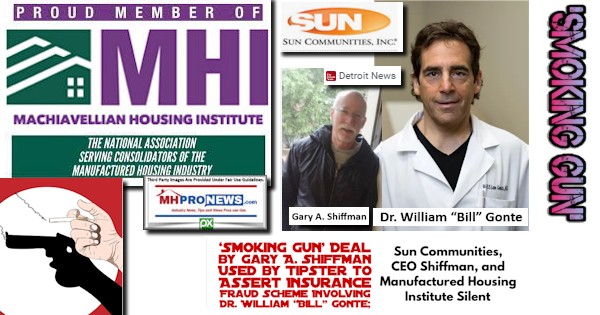
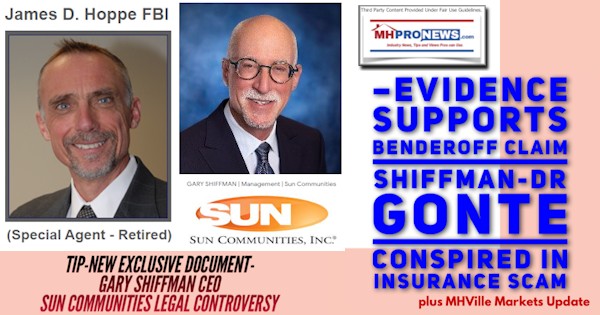
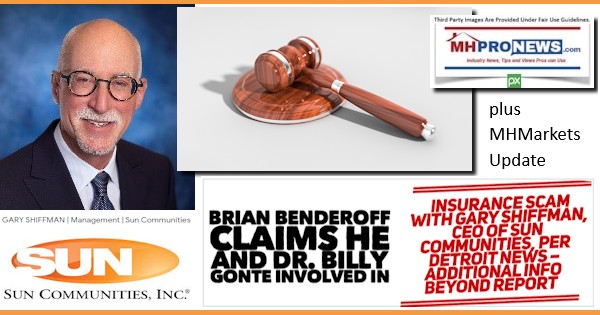
4) According to a WORD search of the above from Blue Orca, there is no apparent mention of class action suits, nor of antitrust allegations involving Sun. Would a better understanding of the various evidence-based allegations made in those class actions filings have had a greater impact on the stock valuation decline? It may. So, it is curious that Blue Orca hasn’t mentioned that – at least yet – with respect to Sun and Shiffman. Blue Orca’s business model, which they frankly stated in their disclosures at the top and end of their presentation, is that they have an agenda of driving down a featured stock’s value, in this case Sun, while noting that even though they have an agenda that doesn’t mean that their analysis is incorrect. Fair enough.
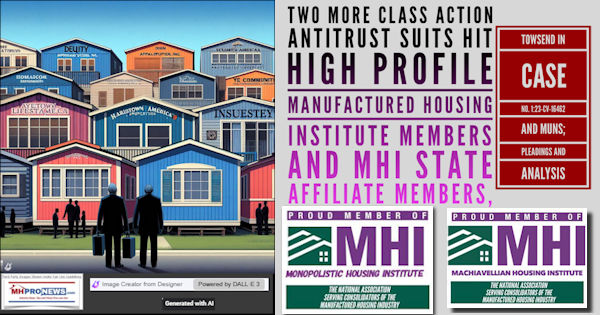
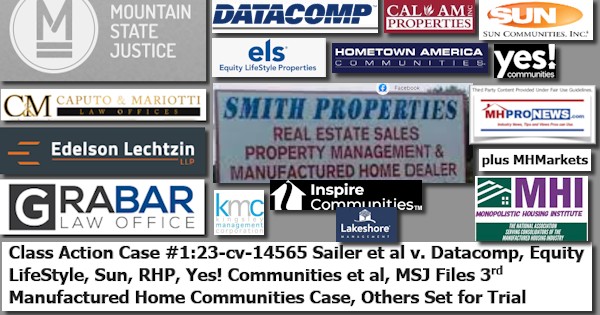

5) In the case of MHProNews, we are neither short nor long on Sun and opt not to invest in Sun or publicly traded manufactured housing connected equities. That isn’t because manufactured housing is a bad investment opportunity, quite the opposite. MHProNews editorially believes, based on evidence and expertise, that manufactured housing could be a superior investment opportunity, and if properly managed, it could be superior to many other possible investment options on the market. Among the reasons manufactured housing ought to be a greater investment is that shelter is one of the necessities of life. As shelter, during an affordable housing crisis, manufactured home industry connected firms ought to be operating at several times its current annual performance. That begs the question, why isn’t the industry performing better than it is? How does that play out in the case of a specific firm, such as Sun Communities? Insights and answers for that are often probed in reports like those linked below.
But to tee them up, Sun’s investment thesis, like that of Equity LifeStyle Properties (ELS) is predicated on what is arguably a flawed thesis. While it may be a challenge for a short seller or investor advocating law firms to quantify some of that, unlike a measurable stock drop as was shown in the preface above, that doesn’t mean that they can’t build a case that could make sense and stand up to legal scrutiny.
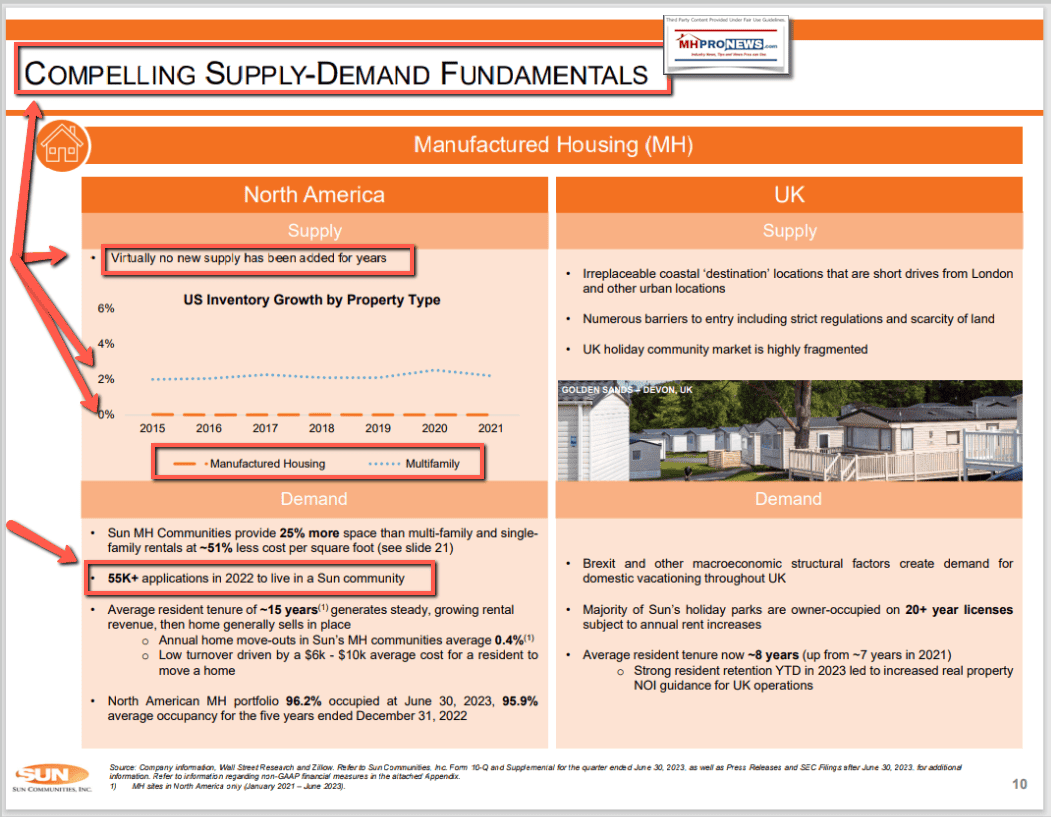
Blue Orca compared Sun to ELS for the purposes of Capex related calculations and arguments. Fair enough. But by failing to look at UMH Properties, or the kinds of analysis found on MHProNews/MHLivingNews, or more recently on the manufactured home related posts on the Patch, Blue Orca is potentially missing out on stronger evidence-based arguments. When Samuel Strommen for Knudson Law quite openly pointed to the importance of his findings on MHProNews, while making a similar argument to Blue Orca’s in the sense that there isn’t a lot of media and research coverage on this segment of the housing market, Blue Orca – and current/potential investors and management are missing out on obvious profit generating opportunities that matter to their respective interests and agendas.

Claimed collusion is something that raises legal, and thus investor, risks. Furthermore, UMH Properties has built a unique investment thesis that is ironically supported by a claim made by Gary Shiffman, albeit obliquely. Namely, that a better return on investment (ROI) can be obtained by developing new communities and new sites instead of relying so much on existing communities which limits the industry’s and thus Sun and other’s opportunities.

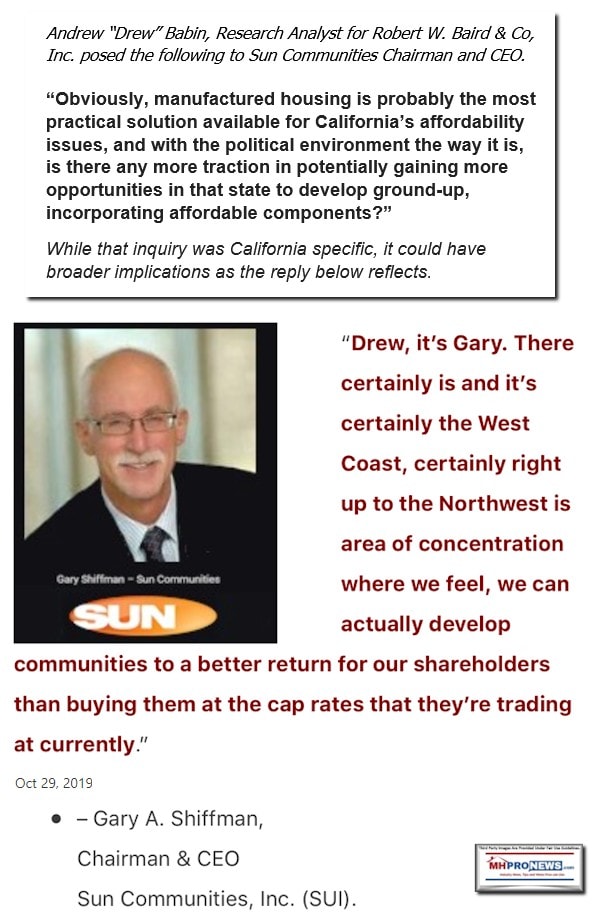
Blue Orca may find that not only Sun, but ELS, Flagship Communities, Berkshire (Clayton Homes parent company), Cavco Industries (CVCO), and Skyline Champion (SKY), among others, could be similarly approached as causes for investor concerns.
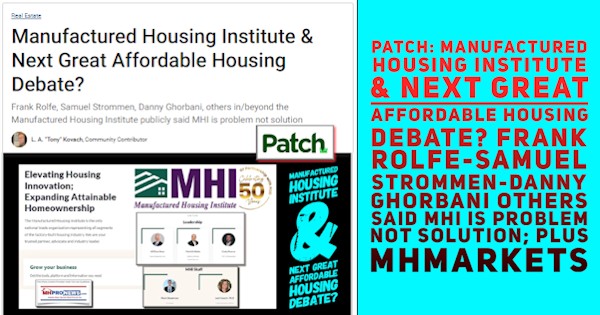
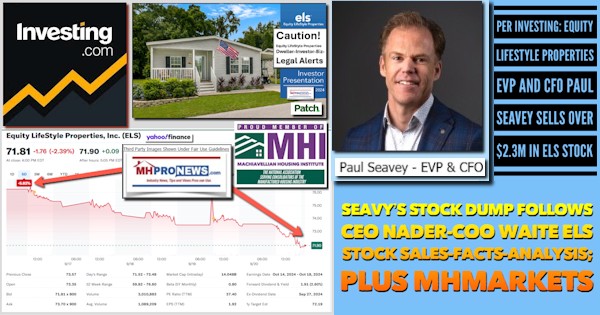
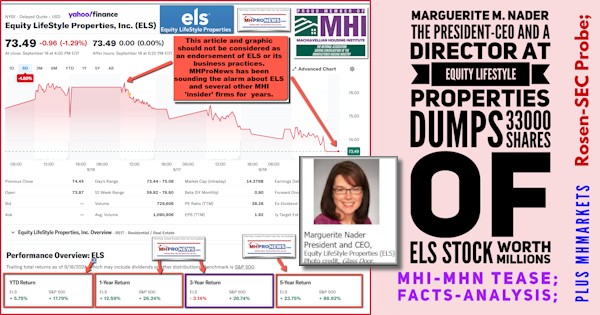
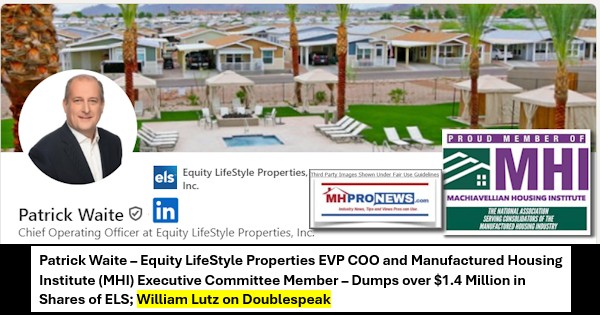
As MHProNews noted above, perhaps due in part to Blue Orca and other attorneys/law firms/investors, etc. looking for research information on Sun, articles related to that firm that are notably Shiffman specific surged recently. That is not unusual. It is a byproduct of more detailed reports with analysis that routinely stand the test of time months or even years after they are published. From time-to-time researchers, attorneys, and others take the time to say thanks for what we do as trade publishers.
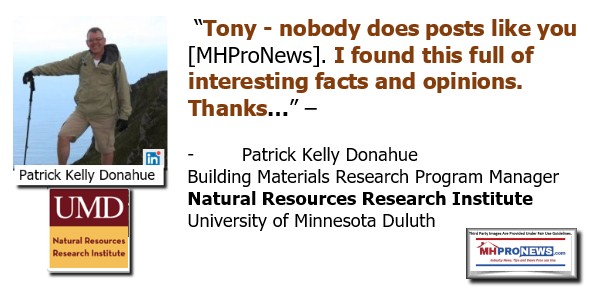

Sometimes those that may have an agenda that is debunked in part due to our reports and analyses express their dislike for our content, which may be a backhanded compliment.
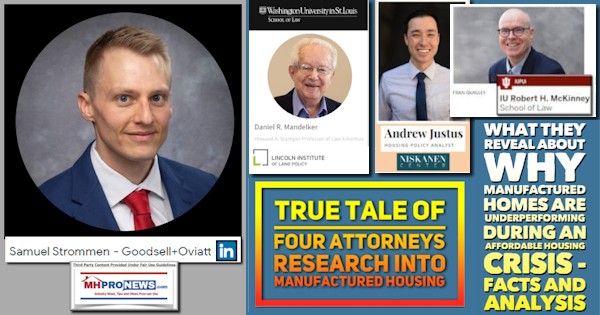
6) Manufactured housing is underperforming during an affordable housing crisis. Blue Orca, regardless of their agenda, may have helped contribute some insights as to why that is so via their report on Sun. While Gary Shiffman certainly has apparently engaged in some egregious and shocking behavior, that doesn’t mean that there aren’t other examples – routinely linked to MHI member firms – that are similar in their stunning shock value. When multi-billion-dollar valuation companies are potentially guilty of causing multiple trillions of dollars of economic harm to the U.S. economy, that ought to be the kind of pile that attracts specialized attorneys and short sellers. But the reverse is also true. If a publicly traded company like UMH Properties (UMH), Legacy Housing (LEGH), and Nobility Homes (NOBH) is keeping their proverbial nose clean from predatory claims and market manipulation allegations, they may attract more investments.
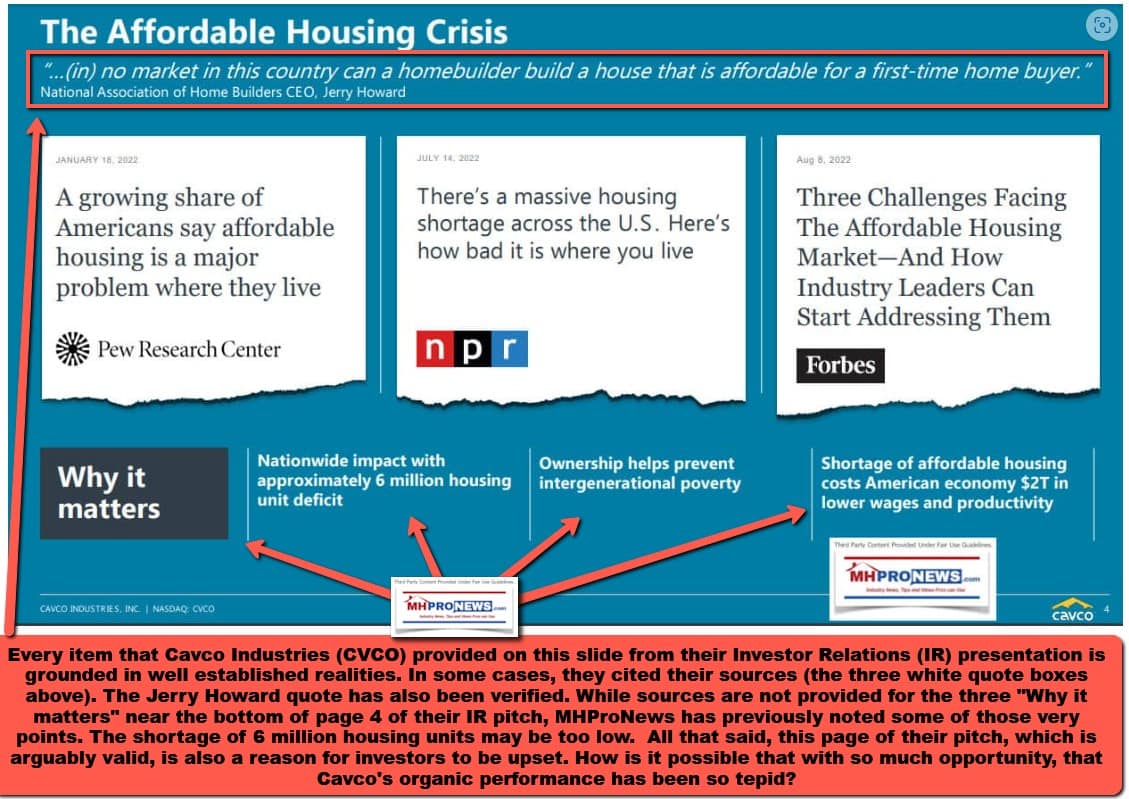
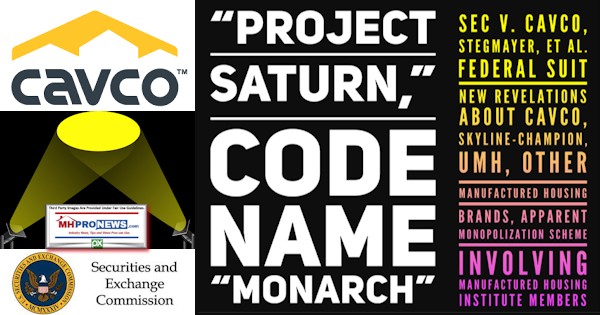
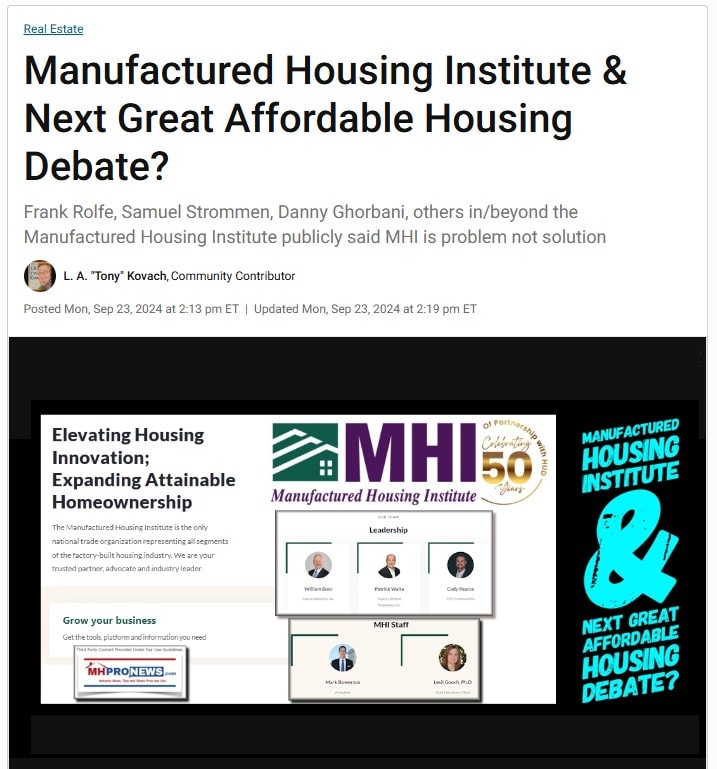

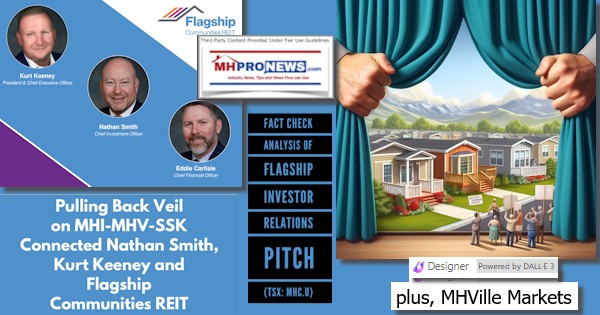
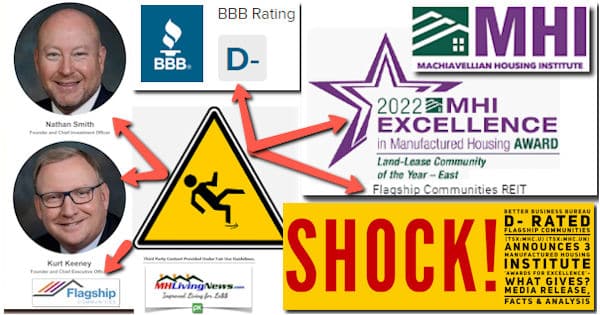
7) Are there evidence-based reasons to be concerned about problems Blue Orca and others have raised about Sun? MHProNews would editorially and in as an industry expert role observe, ‘yes.’ But there may be other issues as or more important than those raised by Blue Orca and those law firms probing Shiffman-led Sun that are not limited to Sun. To learn more, see the linked and related reports. MHProNews plans to monitor these allegations and concerns, and report as deemed warranted. The market report is next up. ##
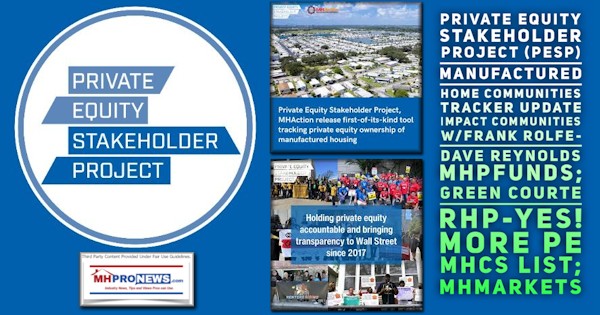

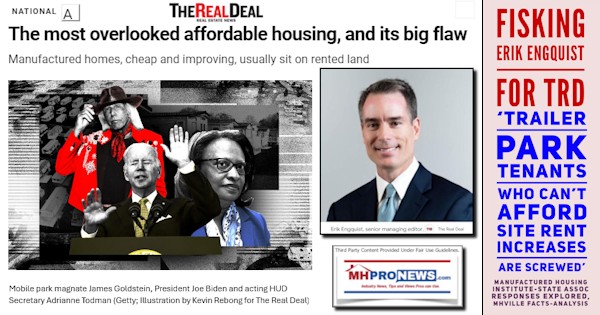
Part VI
Our Daily Business News on MHProNews stock market recap which features our business-daily at-a-glance update of over 2 dozen manufactured housing industry stocks.
NOTICE: following the TPG deal with CAPREIT, TPG has been added to our tracked stocks list below.
This segment of the Daily Business News on MHProNews is the recap of yesterday evening’s market report at the closing bell, so that investors can see-at-glance the type of topics may have influenced other investors. Our format includes our signature left (CNN Business) and right (Newsmax) ‘market moving’ headlines for a more balanced report.
The macro market moves graphics below provide context and comparisons for those invested in or tracking manufactured housing connected equities. Meaning, you can see ‘at a glance’ how manufactured housing connected firms do compared to other segments of the broader equities market.
- In minutes a day, readers can get a good sense of significant or major events while keeping up with the trends that may be impacting manufactured housing connected investing.
Headlines from left-of-center CNN Business – 9.27.2024
- Sima Sistani, who embraced Ozempic, is out as CEO of WeightWatchers
- Moo Deng, a two-month-old female pygmy hippo who has recently become a viral internet sensation, is showered by a zookeeper at Khao Kheow Open Zoo in Chonburi province on September 15, 2024.
- Moo Deng now has her own crypto, because of course she does
- Large scale ‘spooky’ mechanical displays inside a Spirit Halloween store in New York, NY, September 18, 2024.
- You can now order your Spirit Halloween costume on Uber Eats
- Strong economic data this week has kept the party going on Wall Street.
- What’s fueling this week’s record-breaking stock rally
- Jeep vehicles are delivered to a dealership on June 20 in Chicago.
- A dual win for consumers: Inflation cooled last month, paving way for borrowing costs to come down more
- A container ship makes it way toward the Port of New York and New Jersey in Elizabeth, New Jersey. A threatened strike by the International Longshoremen’s Association could shut the port and others on the East Coast and Gulf Coast starting early Tuesday.
- Port workers from Maine to Texas are set to strike Tuesday. Expect shortages and higher prices
- A survey of workers by the Conference Board found that workplace flexibility is the most important element of total compensation beyond a competitive salary.
- Why moves by Amazon and comments by Jamie Dimon don’t threaten an end to remote work benefits
- Pensioners protest the decision of Argentine President Milei’s government not to update minimum pensions in September 2024 in Buenos Aires, Argentina.
- Poverty in Argentina soars to more than 50% as government austerity bites
- Vice President Kamala Harris speaks during a presidential debate with former President Donald Trump at the National Constitution Center in Philadelphia on September 10.
- A $28 trillion problem is about to get much worse. Harris and Trump are ignoring it
- Proto Products_All.jpg
- Hologram boxes can beam ‘3D’ video into your living room
- French tycoon gains $17 billion from China’s economic stimulus push
- Trump Media co-founder and former ‘Apprentice’ contestant dumps about $100 million worth of stock
- Newsmax and Smartmatic settle 2020 election defamation case on eve of trial
- NTSB issues ‘urgent’ safety warning for some Boeing 737s, including MAX, in latest blow to struggling planemaker
- Murdoch family holds its breath as future of media empire hangs in the balance
- Hoda Kotb is leaving NBC’s ‘Today’
- Three more execs out at OpenAI, including technology chief Mira Murati
- Southwest reveals when and how it will get rid of open seating
- The Post Office wants stamp prices to rise five times over the next three years
- Trump’s promises would spike inflation and wipe out jobs, study finds
- Wendy’s takes aim at McDonald’s broken McFlurry machines with a $1 Frosty
- We may have finally pulled ourselves out of our economic funk
- Harris and Trump want to make stuff in America again. That’s really hard to do

Headlines from right-of-center Newsmax – 9.27.2024
- Netanyahu Slams UN as Antisemitic in Fiery Address to World Body
- Benjamin Netanyahu delivers an emphatic address at the United Nations in New York City on Friday. (AP)
- Netanyahu Slams UN as Antisemitic in Fiery Address to World Body
- His leadership strained by conflicts on two fronts, Israeli Prime Minister Benjamin Netanyahu told world leaders at the United Nations on Friday that the organization is antisemitic. He further said his nation would “continue degrading Hezbollah” until achieving its goals along the Lebanon border. [Full Story]
- Related Stories
- Israel Says It Struck Hezbollah’s Headquarters as Huge Explosions Rocked Beirut
- Election ’24: Race for White House
- Trump to Seek Google’s Prosecution If He Wins Election
- CNN Poll: Harris Leads Big in Nebraska’s 2nd District
- Bloomberg Poll: Harris Leads Trump in Swing States
- Emerson Poll: Trump Trails Harris by 14 Points in N.Y.
- Multiple Iranians Indicted Over Trump Campaign Hack
- Israeli Offensive in Lebanon Rekindles Dem Tension in Mich.
- Trump Targeting Mormon Vote in Arizona, Nevada
- Crane: Too Risky for 2nd Trump Rally in Butler
- Newsmax TV
- Walberg: Michiganders See Differences in Trump, Harris
- Sanders: Public ‘Ripped Off’ by Big Pharma
- Malliotakis: NYC Mayor Adams Must Resign
- David Friedman: Biden’s Iran Weakness Emboldens Hezbollah
- Whitaker: Adams Indictment ‘Possibly Part of a Pattern’
- Bolton: Must Step Up Response to Iran
- Alford, Van Drew: Zelenskyy Meddling in Election
- Lewandowski: Harris, Biden Rhetoric Inspired Lone Actors
- RNC’s Whatley: ‘Kamala Harris Is Not Ready for Prime Time’
- Newsfront
- Helene Slams South: 11 Dead in Ga., Millions Lose Power
- Helene roared through Florida and Georgia states under darkness on Friday as one of the most powerful storms to hit the United States, killing one person, swamping neighborhoods and leaving more than 2 million homes and businesses without power. The Category 4 storm hit land…… [Full Story]
- Israeli Military Targets Hezbollah’s Central Command
- The Israeli military said Friday it targeted Hezbollah’s central [Full Story]
- Related
- Lebanon Fears Gaza-like Carnage as Israel Ramps up Airstrikes across the Country
- Netanyahu Slams UN as Antisemitic in Fiery Address
- AP: Newsmax, Smartmatic Settle in 2020 Defamation Case
- A settlement was reached Thursday in a defamation lawsuit brought by [Full Story]
- Related
- Newsmax Statement on Smartmatic Lawsuit Settlement
- Newsmax ‘REVOLT’ EV Documentary Premieres Sunday
- The Newsmax original “REVOLT: The Case Against EV Mandates,” set to [Full Story]
- Dow Closes at Record High on Tame Inflation Report
- The blue-chip Dow Jones Industrial Average closed at a record high [Full Story]
- Uber Eats Partners With Spirit Halloween
- Uber announced Friday it’s partnering with Spirit Halloween to [Full Story]
- Trump Makes Inroads With Black Voters in Arizona
- Former President Donald Trump is making major inroads in Arizona with [Full Story]
- Biden Announces $8 Billion in Military Aid for Ukraine
- President Joe Biden announced more than $8 billion in military [Full Story]
- Related
- Russia Targets Kyiv for 5 Hours, Hitting Ukraine Power Grid
- Zelenskyy Visiting White House Amid Partisan Divide on Ukraine
- US Sending $375M in Aid to Ukraine, Billions More Coming
- Harris, in Zelenskyy Meeting, Blasts Calls for Ukraine to Cede Territory to Russia
- Trump: Will Meet Ukraine’s Zelenskyy on Friday
- UAE Foreign Minister Says His Country Is Doubling Down on US Ties
- The United Arab Emirates is strengthening its relationship with the [Full Story]
- Blinken Calls Putin Nuclear Comments Irresponsible
- Secretary of State Antony Blinken called Russian President Vladimir [Full Story]
- Related
- Kremlin: Putin’s Nuke Policy Changes a Warning to West
- Harris Says Being Safe Is Civil Right, as Biden Signs Order on Gun Tech
- Vice President Kamala Harris said Thursday she believed right to be [Full Story]
- Related
- Biden-Harris Gun Order to Fund States’ Red-Flag Laws
- Kelly: Secret Service ‘Failures’ Led to Trump Shooting
- Mike Kelly, R-Pa., chairman of the House task force [Full Story]
- Related
- Leavitt to Newsmax: Harris, Biden Silence on Iran Plot to Kill Trump ‘Deafening’
- Iran Denies Trump’s Charges of Targeting Ex-US Officials
- Trump on Assassination Threats: ‘We Are Going to Blow Your Largest Cities and the Country Itself to Smithereens’
- Biden Cabinet Member: ‘Extinguish’ Trump ‘for Good’
- Lead Butler Secret Service Agent Knew ‘Credible’ Threat, Didn’t Act
- Senate Report: Security Failure at Trump Rally Shooting ‘Preventable’
- Crane: Too Risky For 2nd Trump Rally in Butler
- $3 Ivermectin Made in the USA
- All Family Pharmacy
- Russia, China, Target US in Race for the Arctic
- Rogue nations and bad actors are assembling on the world stage to [Full Story] | Platinum Article
- McConnell-Linked Fund Snubs GOP Senate Critics
- Conservatives are complaining that Senate Minority Leader Mitch [Full Story]
- Titan Hearing Bares Reckless Greed and Explorer Passion
- A Coast Guard official testified Friday that he was surprised to [Full Story]
- Y. Appellate Court: Trump Fraud Ruling ‘Troubling’
- A New York appeals court seemed skeptical about the massive $454 [Full Story]
- Biden China Car Tech Ban Could Cut 25K US Auto Sales
- The Commerce Department said Friday that new rules proposed to ban [Full Story]
- Schiff Aims to Thwart Trump Ducking Prosecutions
- Adam Schiff, D-Calif., on Friday introduced a bill aimed at [Full Story]
- ICE: More than 662K Immigrant Criminals on Docket
- Federal records show that there are more than 662,566 immigrant [Full Story]
- Trump, Zelenskyy Meet in NY Amid Rising Questions
- Ukrainian President Volodymyr Zelenskyy arrived Friday for a meeting [Full Story]
- Shipbuilder: Bad Welds on Navy Ships May Be Intentional
- Shipbuilder: Bad Welds on Navy Ships May Be Intentional
- A Virginia shipbuilder has informed the Department of Justice that [Full Story]
- Embattled NYC Mayor Adams Arrives for Arraignment
- Embattled New York City mayor Eric Adams arrived at a federal [Full Story]
- Major Insider Slashes Stake in Trump’s Media Firm
- One of the biggest shareholders in former U.S. President Donald [Full Story]
- Inflation Slows, Consumer Spending Rises Moderately
- S. consumer spending increased moderately in August, suggesting the [Full Story]
- Many Wall Street Executives Distrustful of Harris
- Many Wall Street executives have reservations about backing Democrat [Full Story]
- X Seeks Brazil to Lift Ban After Acting on Judge’s Orders
- Elon Musk’s social media site X has complied with Judge Alexandre de [Full Story]
- Boar’s Head Investigated Over Listeria Outbreak
- The U.S. Department of Agriculture said Thursday that Boar’s Head [Full Story]
- Trump Targeting Mormon Vote in Arizona, Nevada
- Former President Donald Trump is looking for some Latter-day Saints [Full Story]
- Comer, Langworthy Investigate FCC Over Soros Deal
- House Republicans are probing the Federal Communications Commission [Full Story]
- Serbian President, Netanyahu Meet on Sidelines at UN
- As the 79th session of the U.N. General Assembly is underway in New [Full Story]
- NTSB Issues Urgent Safety Guidance on Boeing 737 Rudder
- The National Transportation Safety Board on Thursday issued urgent [Full Story]
- More Newsfront
- Finance
- Latest Inflation Data Boost Case for Big Fed Rate Cuts
- Slowing inflation in August buttressed arguments Federal Reserve officials used in defense of their decision to lower interest rates by half of a percentage point last week and prompted traders to bet the U.S. central bank will continue a fast pace of rate cuts …. [Full Story]
- Trump to Seek Google’s Prosecution If He Wins Election
- Electric Vehicle Revolution DELAYED. What’s Going On?
- The Fed Passes a Half-Point Rate Cut and Gold Rallies
- Small Businesses Prioritize Economy Ahead of Election
- More Finance
- Health
- Best Breakfast for Beating Dementia
- Research shows that what you choose for your morning meal may help preserve cognitive function. According to WebMD, breakfast kick-starts your metabolism, helping you burn calories throughout the day. It also gives you energy and helps you focus on work or at school. Many…… [Full Story]
- 6 Exposed Healthcare Workers Show Bird Flu Symptoms
- FDA Approves Dupixent to Treat ‘Smoker’s Lung’
- US E-Bike, Scooter Injuries Are Soaring
- Fertility Treatment Raises Babies’ Heart Defect Risk
- Experimental Drug Eases Ulcerative Colitis
- FDA Approves New Kind of Drug for Schizophrenia
- Gum Disease Bacteria Linked to Head and Neck Cancers
- A Better Night’s Sleep Is as Easy as 3-2-1


